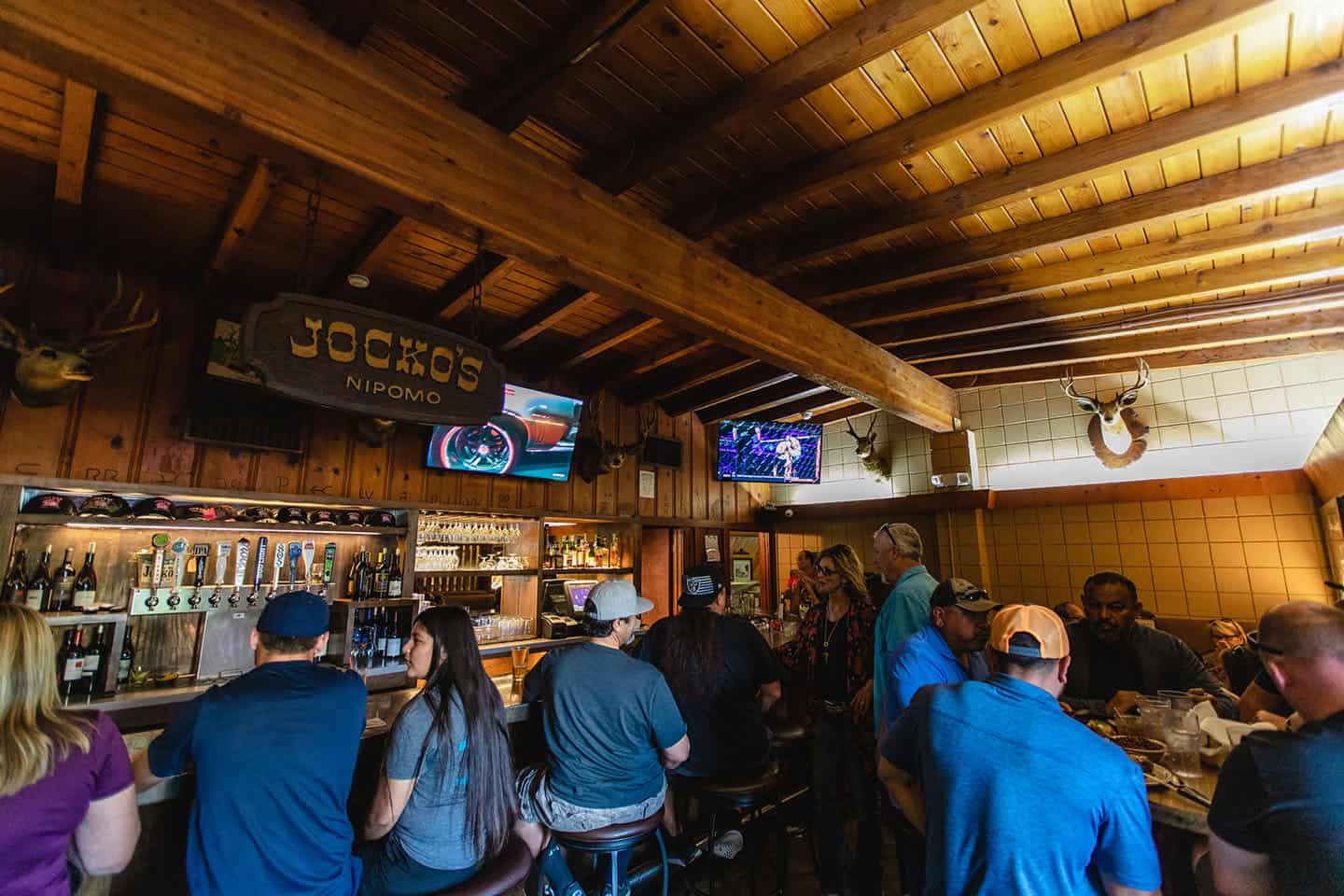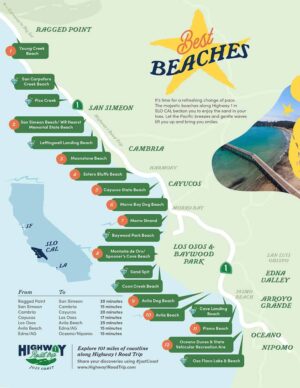Looking for things to do and on Highway 1? With serene beaches and historic piers, farm-fresh dining and ocean views, this iconic scenic route offers an array of unforgettable coastal experiences. Explore sun-drenched dunes, hidden waterfalls and cultural gems on this iconic stretch of California roadway. With boundless things to see on Highway 1, expect the unexpected: From whale watching to wine tasting, horseback riding to kayaking, there’s always more to discover around the bend. Your ultimate Highway 1 road trip awaits. Simply delve into this curated list of essential Highway 1 attractions sure to kick start the imagination.
Explore Highway 1
Things to do in Ragged Point
Ragged Point earns its title as “The Gateway to Big Sur.” Along this stretch of Highway 1, find towering forested mountains cascading into the blue ocean horizon. Here, the journey into miles of pristine and untouched terrain begins, offering a view that substantiates its reputation. In fact, Ragged Point boasts one of the finest vistas along Highway 1, making it an ideal stop for a memorable selfie. Don’t miss “The Million Dollar View,” a circular sculpture strategically positioned to overlook the shoreline. Through its central aperture, you’ll discover a perfect frame for capturing the sheer magnificence of Big Sur’s untouched natural splendor. Anchoring this must-stop landmark is Ragged Point Inn, providing an inviting space to relish the experience. The inn’s expansive lawn area offers seating, beverages and food, creating an idyllic setting for a picturesque picnic.
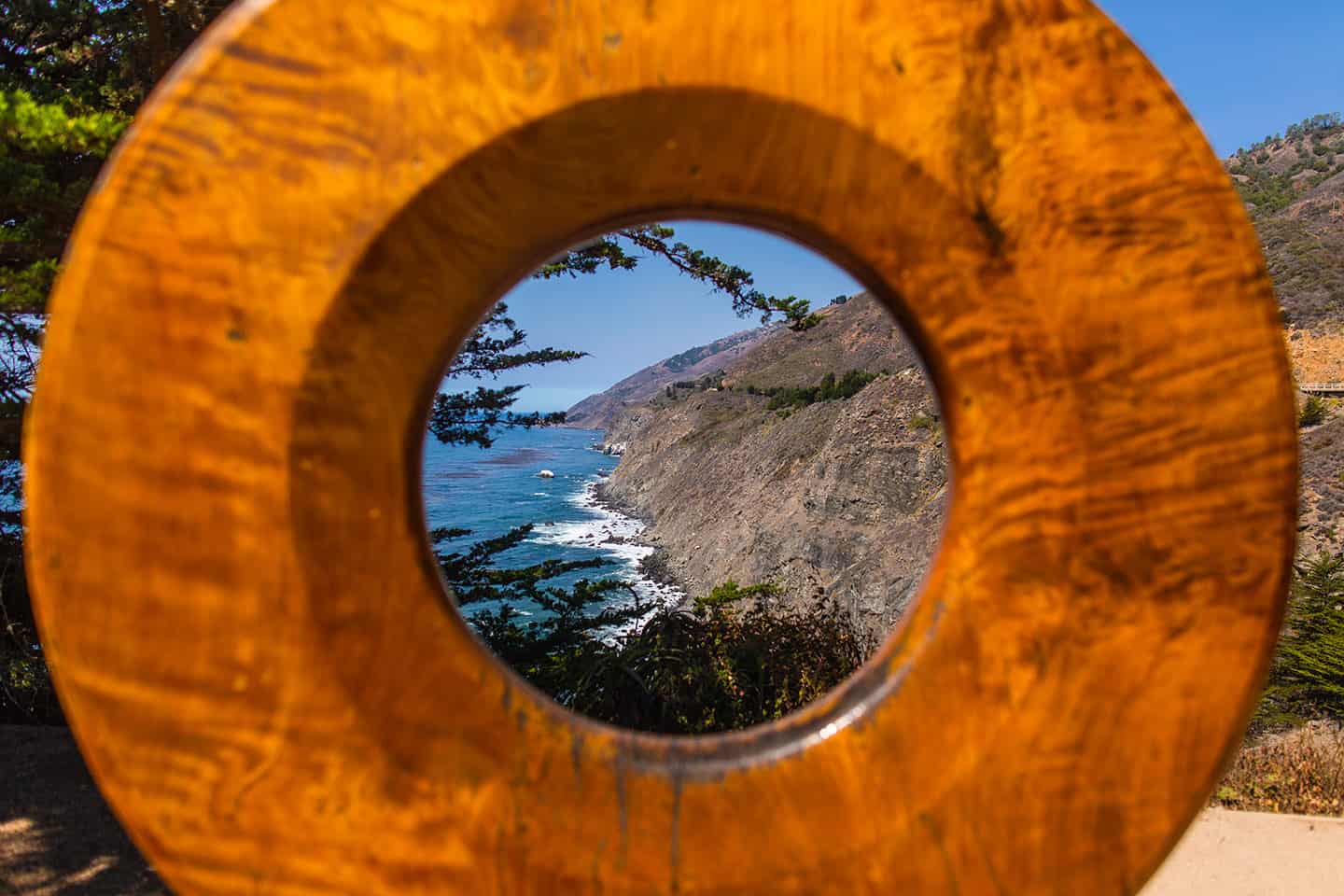
Waterfalls of Ragged Point
Black Swift Falls
Nestled just below the Million Dollar View sculpture in San Simeon, uncover Black Swift Falls. This seasonal waterfall cascades 300 feet down to the ocean—well worth the trek. You can find the trailhead for a short, steep hike to the beach right by the Million Dollar View on Highway 1. Once you pull over, equip yourself with sturdy hiking shoes (note: avoid sandals), and embark on the quick descent to the water. The hike is under a mile round-trip, but be prepared for challenging terrain. Upon reaching the bottom, notice the beach’s distinctive black sand, a result of ancient volcanic activity. Thanks to its composition, this sand retains heat from the sun and provides warmth even on cooler days. Relax on the beach, feel the sand underfoot, observe the rolling ocean waves, and let the waterfall’s soothing sound envelop you.
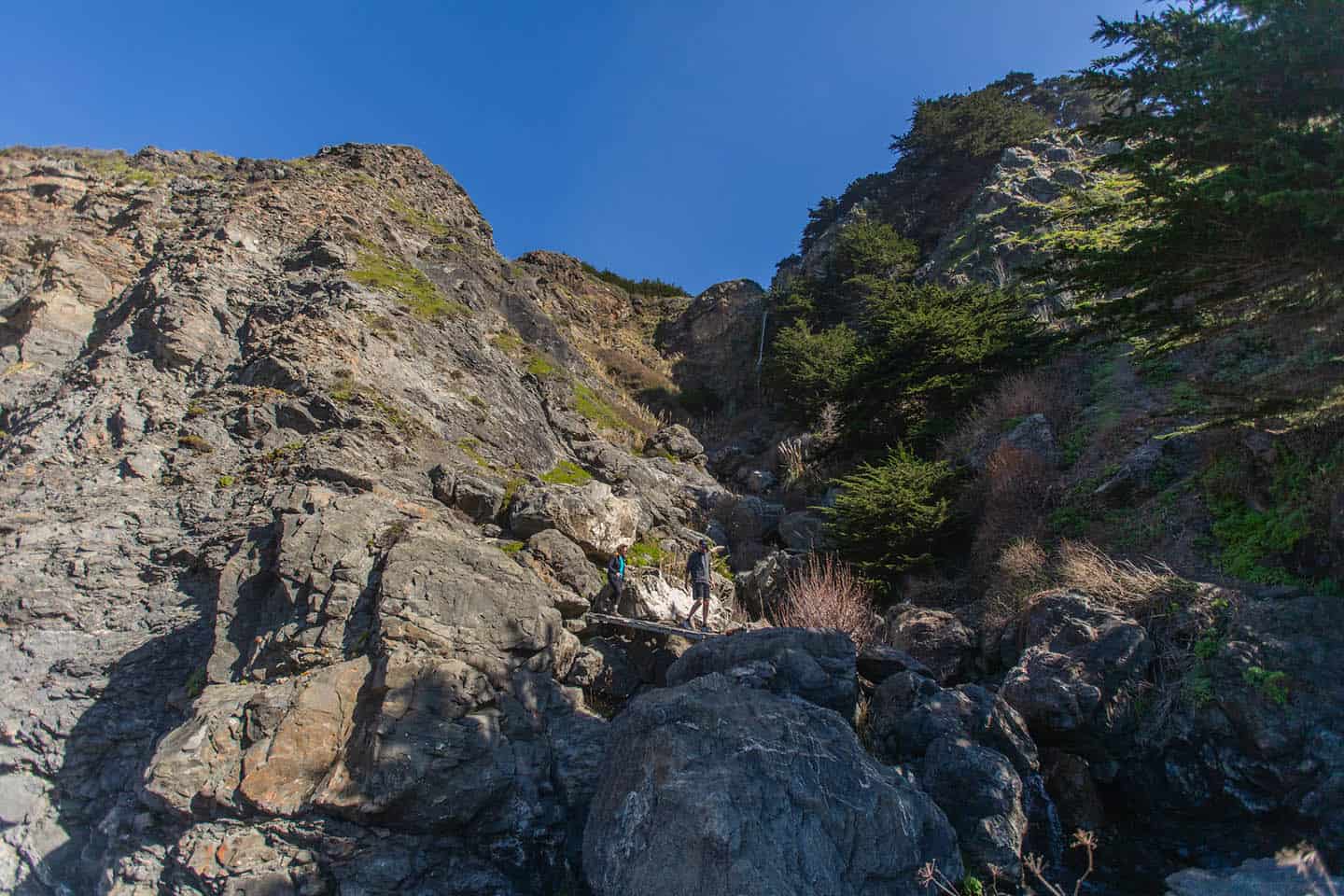
Salmon Creek Falls
A mere 3 miles north of Ragged Point, Salmon Creek Falls offers another captivating spot to witness the beauty of a classic Big Sur waterfall. Though not towering like Black Swift Falls, Salmon Creek waterfall stands impressive at 120 feet. Convenient to access, the waterfall is a quick quarter-mile stroll from the trailhead off Highway 1. The path winds through an oak forest to a stream, providing fishing opportunities for licensed anglers. After viewing the waterfall, hikers can venture deeper into the Silver Peak Wilderness. Following the Salmon Creek Trail for an additional 2 miles leads to Spruce Camp, with Estrella Camp another 1.25 miles ahead. For the ambitious hiker, the entire Salmon Creek Trail spans 6.5 miles round-trip, featuring challenging terrain and a 1,300-foot elevation gain. Alternatively, savor the remote tranquility of Big Sur’s wilderness by simply unwinding by the waterfall and soaking in the sights and sounds.
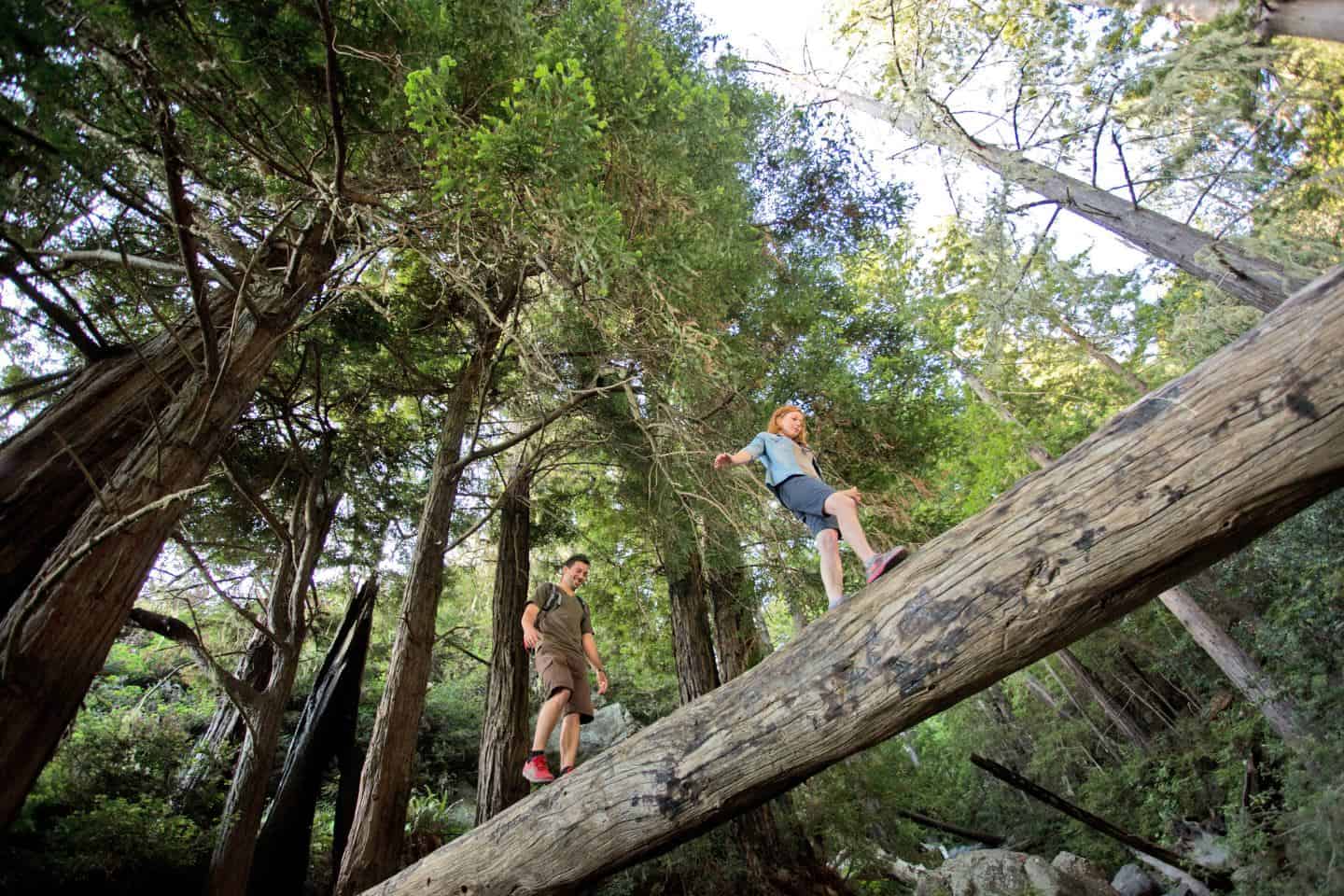
More Ragged Point Adventure
Looking for more things to do in Ragged Point? The Gateway to Big Sur is the best place to take in an epic sunset along Highway 1. Stop at Ragged Point Inn’s grassy outlook, where lounge chairs are available for all to enjoy. Hungry? Tuck into a cliffside meal at the inn and even take in a spa service. After hiking to a hidden waterfall, relax with an afternoon of live music. Surrounded by food vendors and small shops, the inn’s sun-dappled plaza serves as a concert hall and meeting place for visitors.
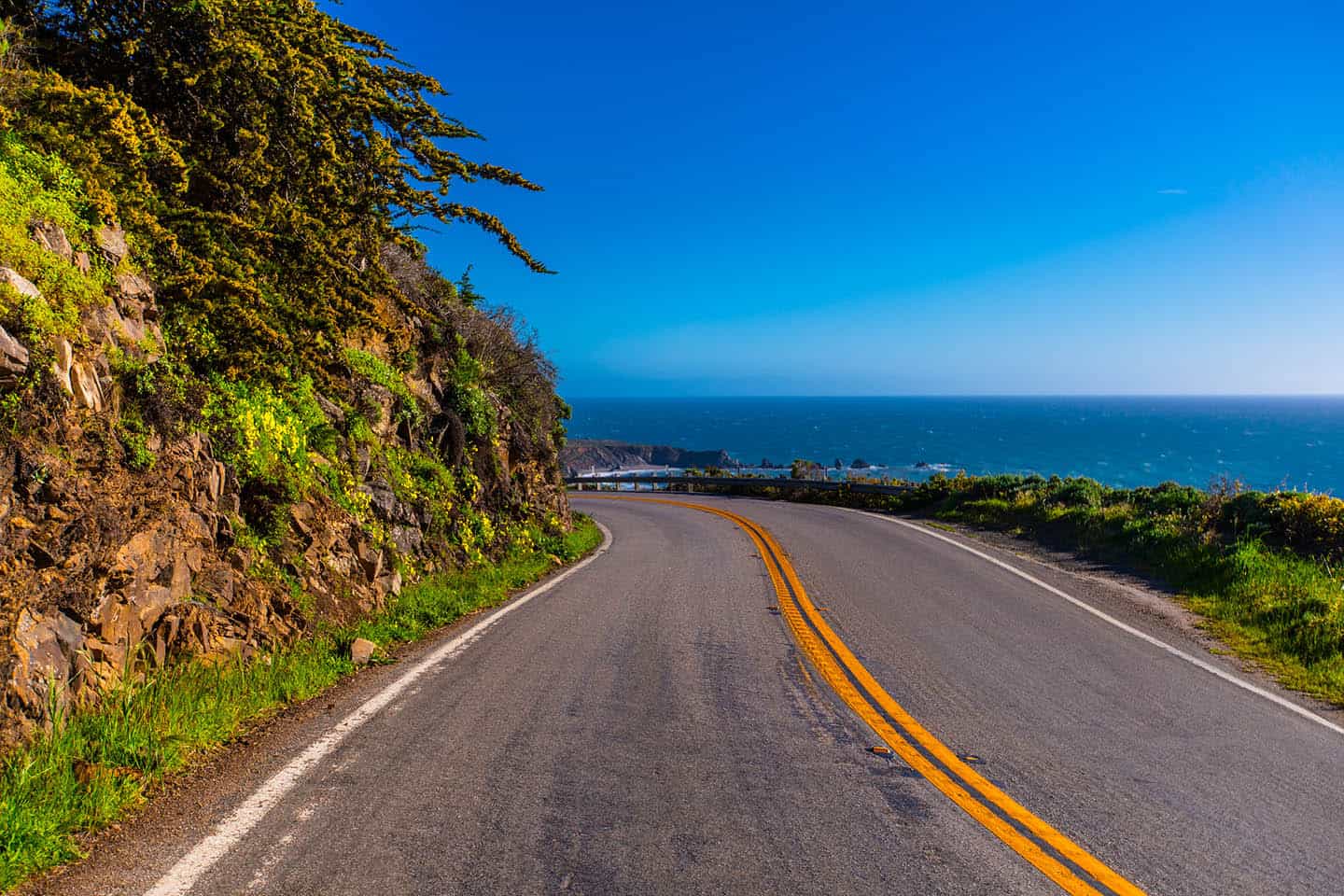
Local Dining Favorite
Ragged Point Restaurant
Savor dinner accompanied by stunning Pacific ocean vistas at Ragged Point Restaurant. For those seeking a classic seated meal, secure a coveted cliffside table. Indulge in a range of local wine choices and seasonal dishes prepared with regional ingredients. The menu presents a blend of fresh seafood, regional produce and steaks, bringing together the best elements of land and sea.
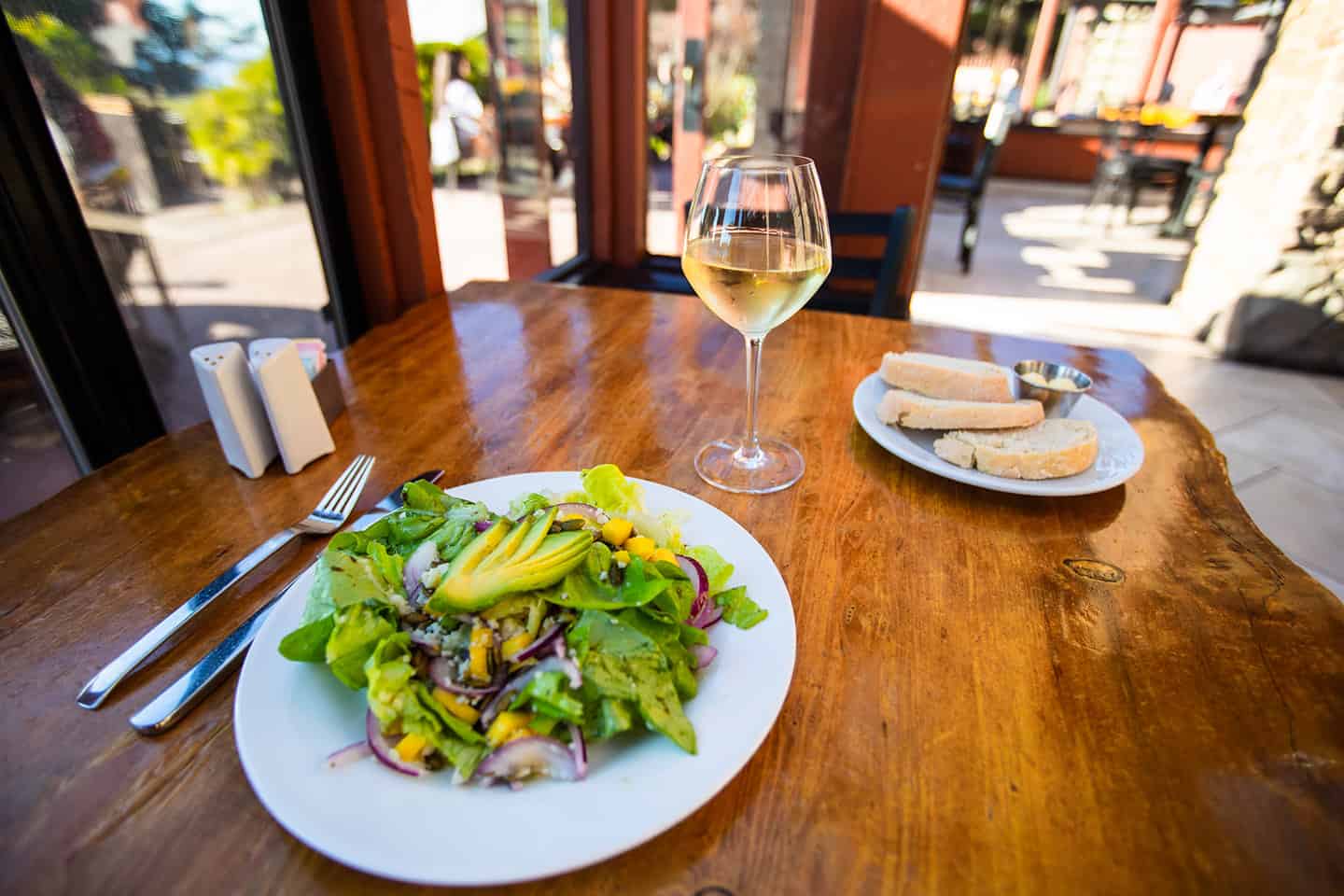
Things to do in San Simeon
Elephant Seal Rookery
Don’t miss the Piedras Blancas Elephant Seal Rookery, a free wildlife habitat located near San Simeon on the west side of Highway 1. Here, visitors have the rare opportunity to witness majestic Northern Elephant Seals up close, just a few feet from the viewing area. Spanning 8 miles of coastline, the rookery is a bustling beach where elephant seals congregate. The colony, now around 25,000 strong, can be observed from a privileged viewpoint. Conveniently situated right off Highway 1, this stop is accessible to all. The optimal viewing time spans from early winter through late fall when visitors can watch seals arrive ashore to give birth and mate. Marvel at the intense battles among the dominant bull seals competing for breeding rights and listen to the adorable sounds of the newborn pups. The experience is made even better by an elevated viewing deck and dedicated parking lot. For deeper insights, visit the new visitor center of the Friends of the Elephant Seals, located near the Cavalier Oceanfront Resort in San Simeon.
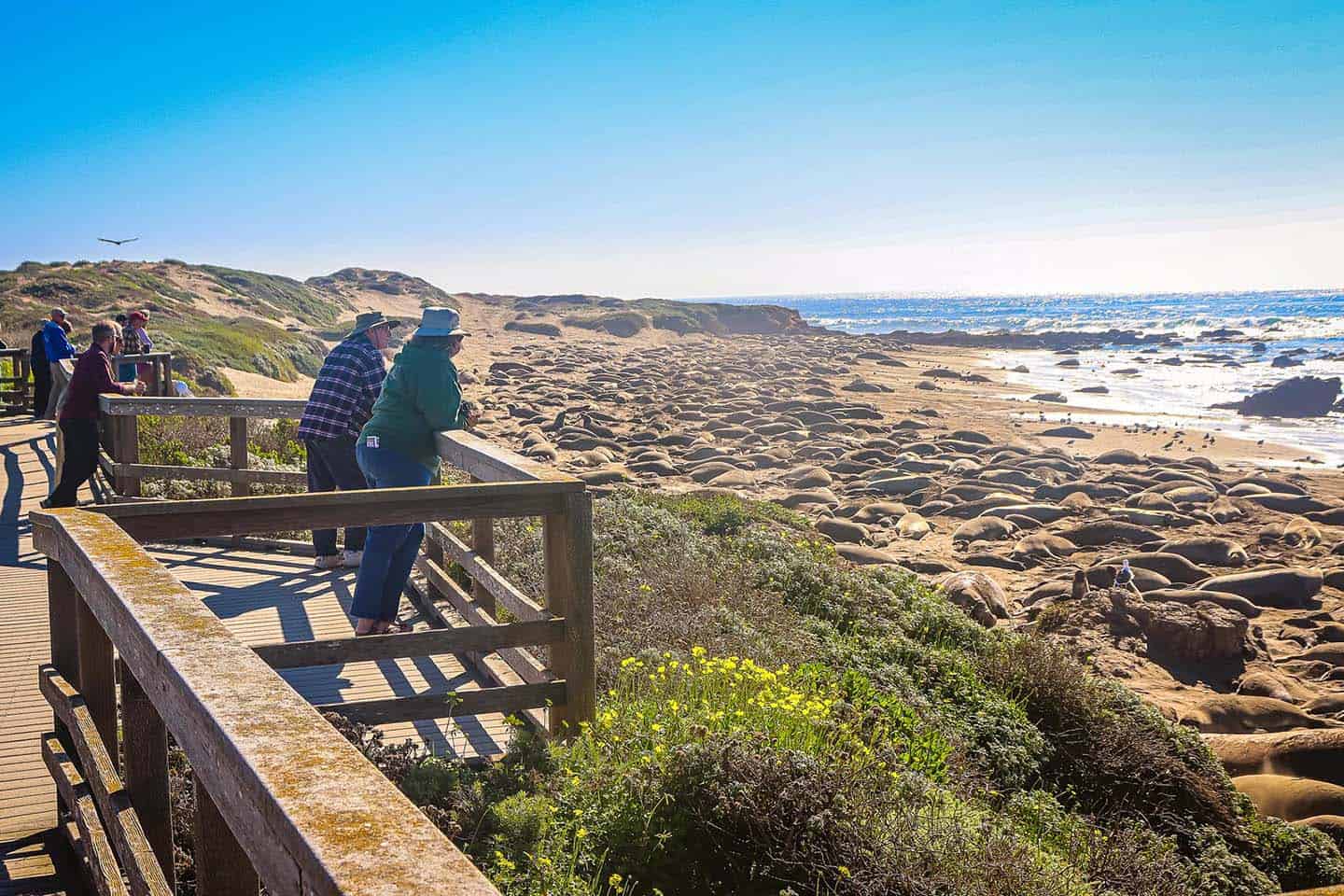
Zebra Spotting
While driving along scenic Highway 1 in San Simeon, keep an eye out for an unexpected sight: zebras. The historic Hearst Ranch along this route is home to a mysterious population of free-roaming zebras, descendants of the private zoo once owned by William Randolph Hearst. Be sure to have your camera ready for an unforgettable glimpse of these exotic animals set against the stunning backdrop of Highway 1.
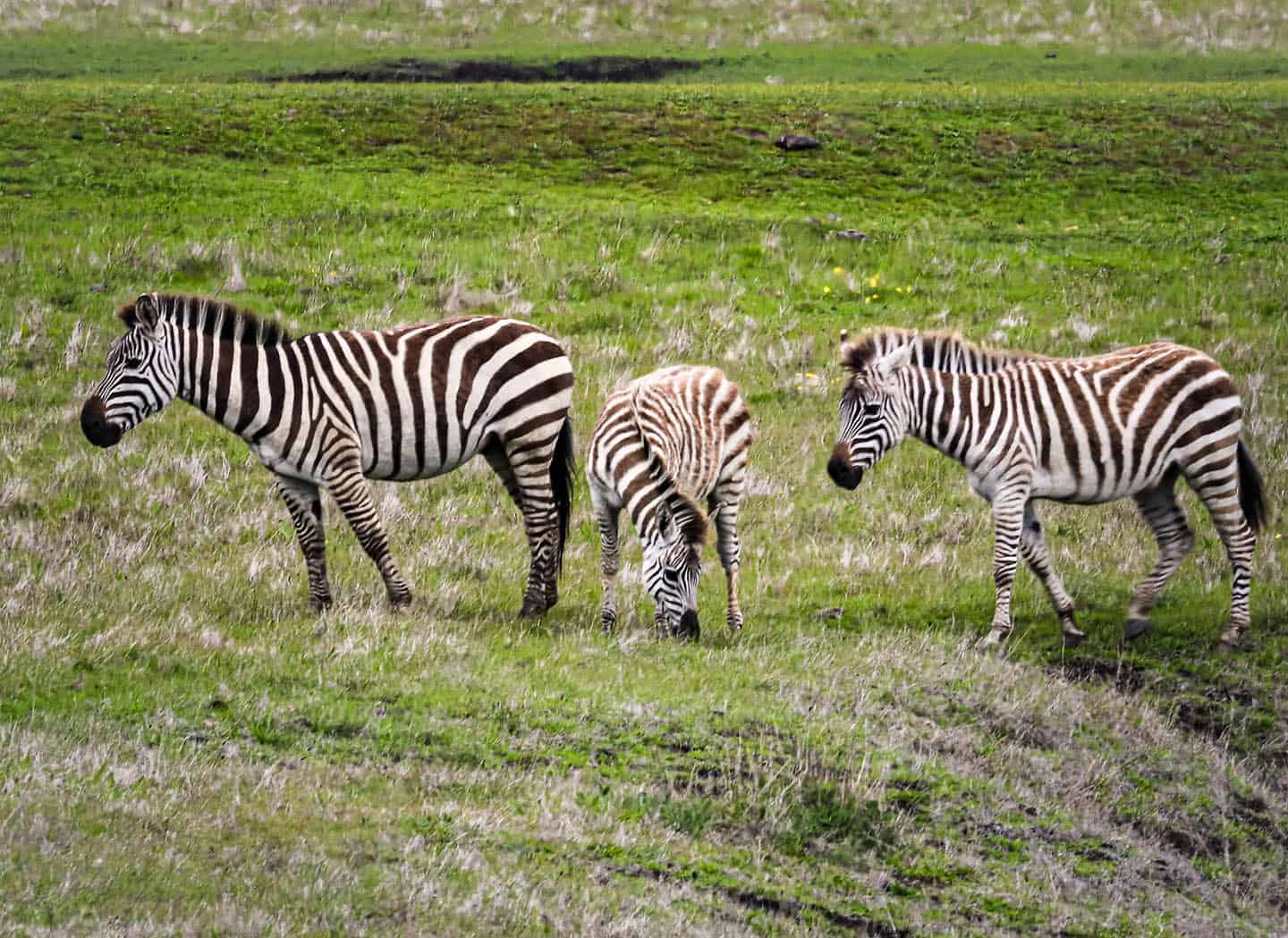
Grand Engineering in San Simeon
Piedras Blancas Light Station
Perched along Highway 1, the historic Piedras Blancas Light Station in San Simeon casts its light every 10 seconds. Replacing the original 1872 French-made Fresnel lens, the Vega VRB-25 lens now takes center stage, while the Fresnel lens can be admired at the Lions Club in Cambria. Despite the change in lenses, the mechanics of this significant 1875 lighthouse remain unaltered. While contemporary mariners may not rely on its guidance along this coastline, its historical importance endures. Today, visitors can explore the lower level of the lighthouse and the iconic Fog Signal Building. Guided by docents from the Piedras Blancas Motel, owned by the State Park system, visitors are led to the lighthouse while absorbing captivating stories and insights. While reservations are necessary, select seasons offer the opportunity to journey to the lighthouse from the nearby Boucher Trail on foot.
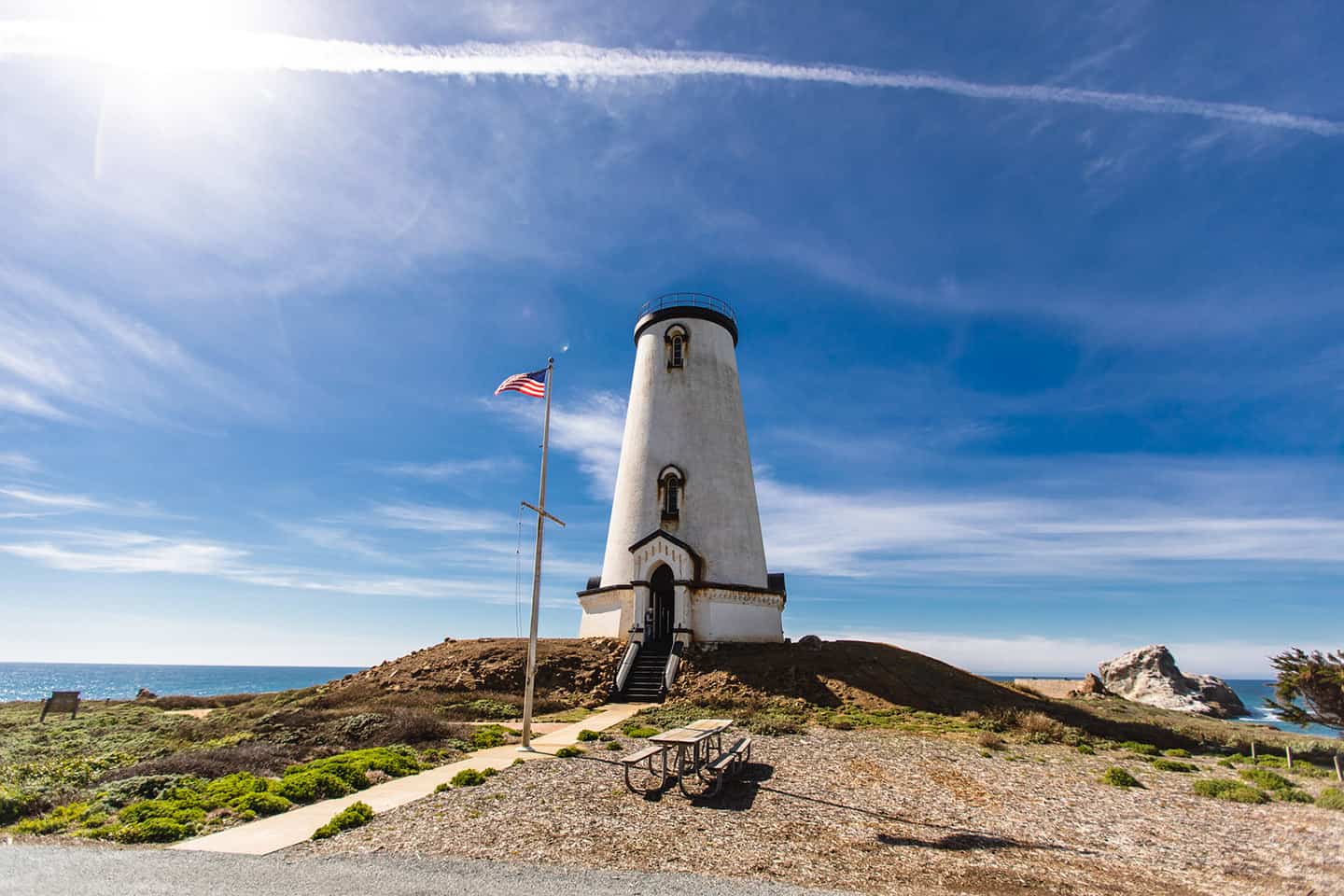
Hearst Castle
San Simeon’s Hearst Castle is known worldwide for its grand architecture, rare collection of antiques and larger-than-life history. Famously owned by late newspaper magnate William Randolph Hearst, this opulent estate is open to the public, allowing anyone to catch a glimpse of Hearst’s lavish lifestyle. Born in 1863 to a prosperous miner, landowner, and politician, Hearst grew up with an eye for worldly design. His ambitious hilltop residence in San Simeon was designed with distinctive flair by famed architect Julia Morgan, who collaborated with Hearst from 1919 to 1947. Since the 1950s, Hearst Castle has been owned by the state of California, offering year-round tours. The sprawling 90,000-square-foot castle, including guest cottages, pools and manicured gardens, warrants multiple visits. Regular and seasonal tours are available, providing a comprehensive exploration of Hearst’s museum-like estate.
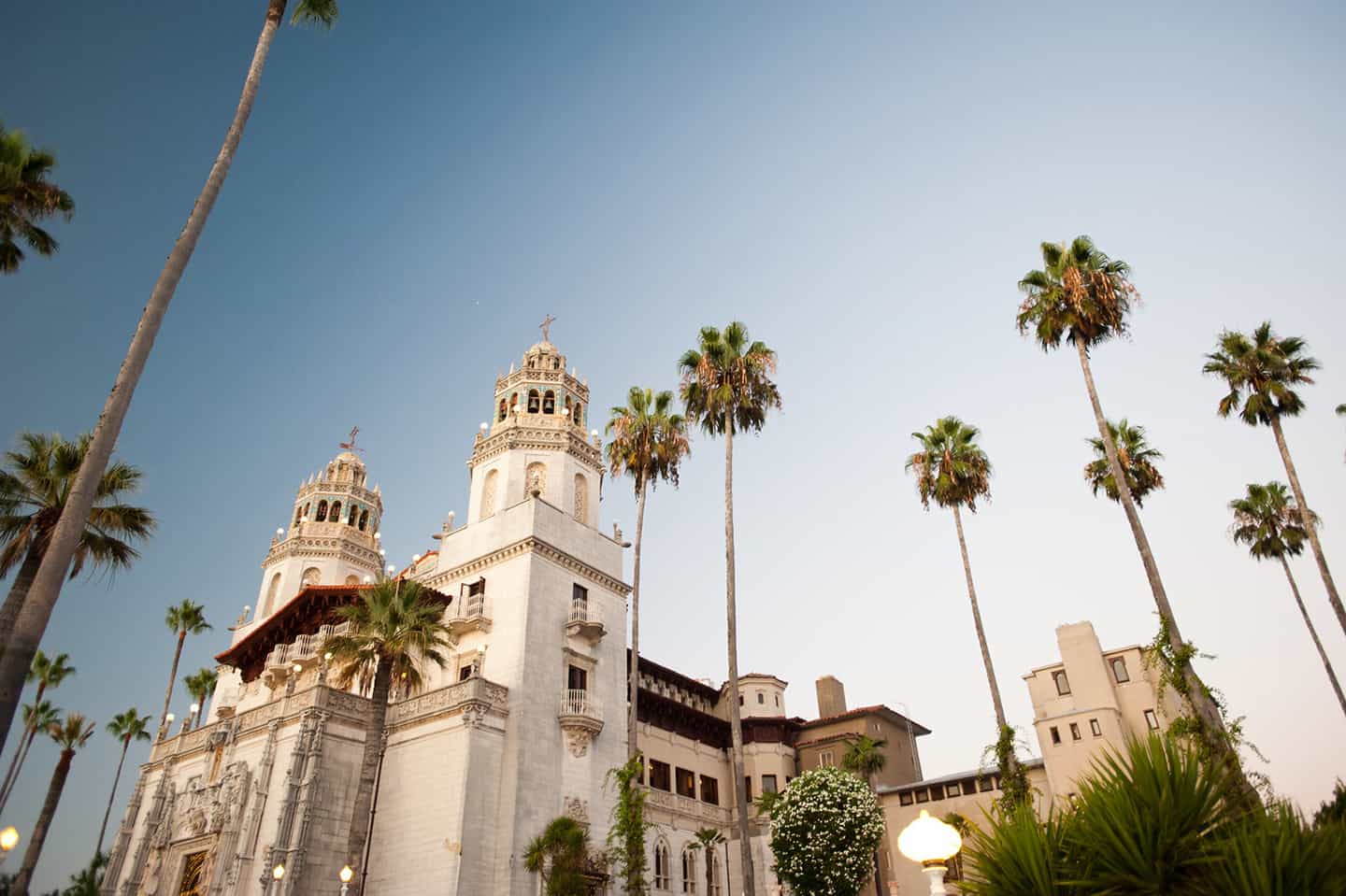
More San Simeon Adventure
Looking for things to do in San Simeon? View seabirds and whales while strolling the San Simeon Pier Walk or take in the view from San Simeon Point, a photogenic viewing area located nearby. Stroll through the historic Village of San Simeon, visitors can wine taste at Hearst Ranch Winery. Here, ocean views come together with outdoor tasting tables and an onsite gourmet food truck. Looking to unwind? Partake in a game of billiards at San Simeon Beach Bar and Grill or simply relax with a rejuvenating massage at one of many area spas.

Local Dining Favorite
Cavalier
San Simeon’s Cavalier restaurant is an upscale dining destination with impressive ocean views only rivaled by Hearst Castle. In fact, this epic Highway 1 restaurant literally touches the sand. Serving up juicy Hearst Ranch Beef as well as plant-based options, find fresh seafood and decadent desserts, too. Paired with world class wines and craft cocktails, Cavalier is a cut above. Hungry visitors should also check out our full overview of the best San Simeon dining experiences and restaurants.

Things to do in Cambria
Moonstone Beach
Moonstone Beach stands out as a one-of-a-kind destination, offering an abundance of unique experiences. A paradise for beachcombers, discover an assortment of stones, sea glass and driftwood along the scenic shoreline. The variety of stones found along the sand—including “moonstone,” or translucent microcrystalline quartz—sets Moonstone Beach apart. Visitors may also come across jade and agate stones smoothed by the ocean’s currents. If collecting rocks isn’t on the agenda, the Moonstone Beach Boardwalk runs along the beach, providing excellent ocean views with seating areas. Covering about 2 miles roundtrip, this wheelchair and stroller-accessible boardwalk offers a serene oceanfront stroll suitable for everyone.
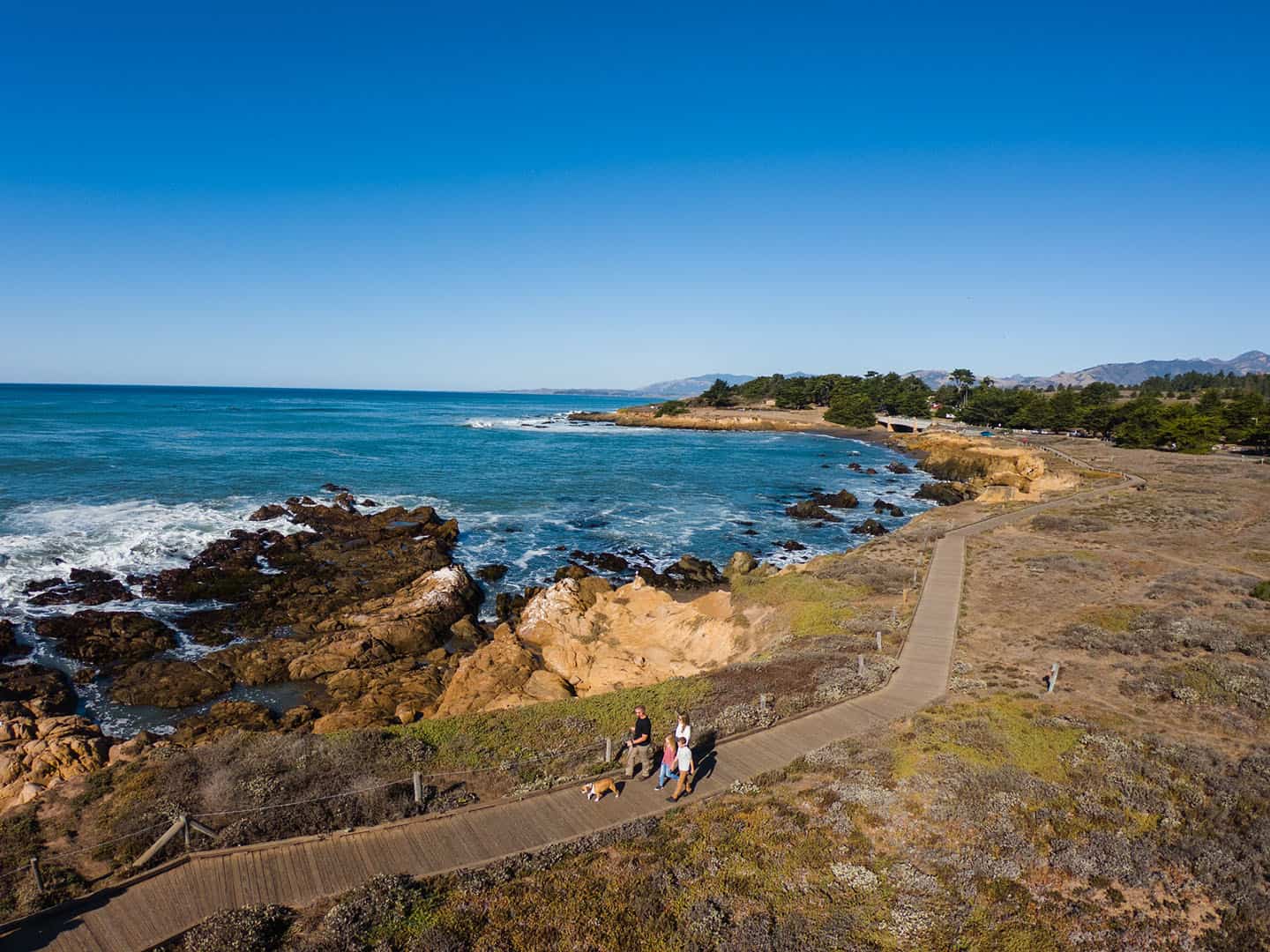
The Heart of Cambria
The Village
Located where pines meet the sea, Cambria is a natural wonder worthy of a daytrip. This beach community’s appeal is concentrated in its quaint village epicenter: Stroll the downtown area for an enchanting blend of history, art and flavor. Walkable and full of boutique shopping, intimate dining, wine tasting and antiques. The village boasts two sides—the East Village and the West Village. While each side has their own advantages, both showcase great independent and family owned businesses. Indulge in tea houses, candy stores, garden shops and art galleries. Visitors looking to delve deeper into Cambria history can take a historic walking tour of downtown provided by the Cambria Historical Museum.
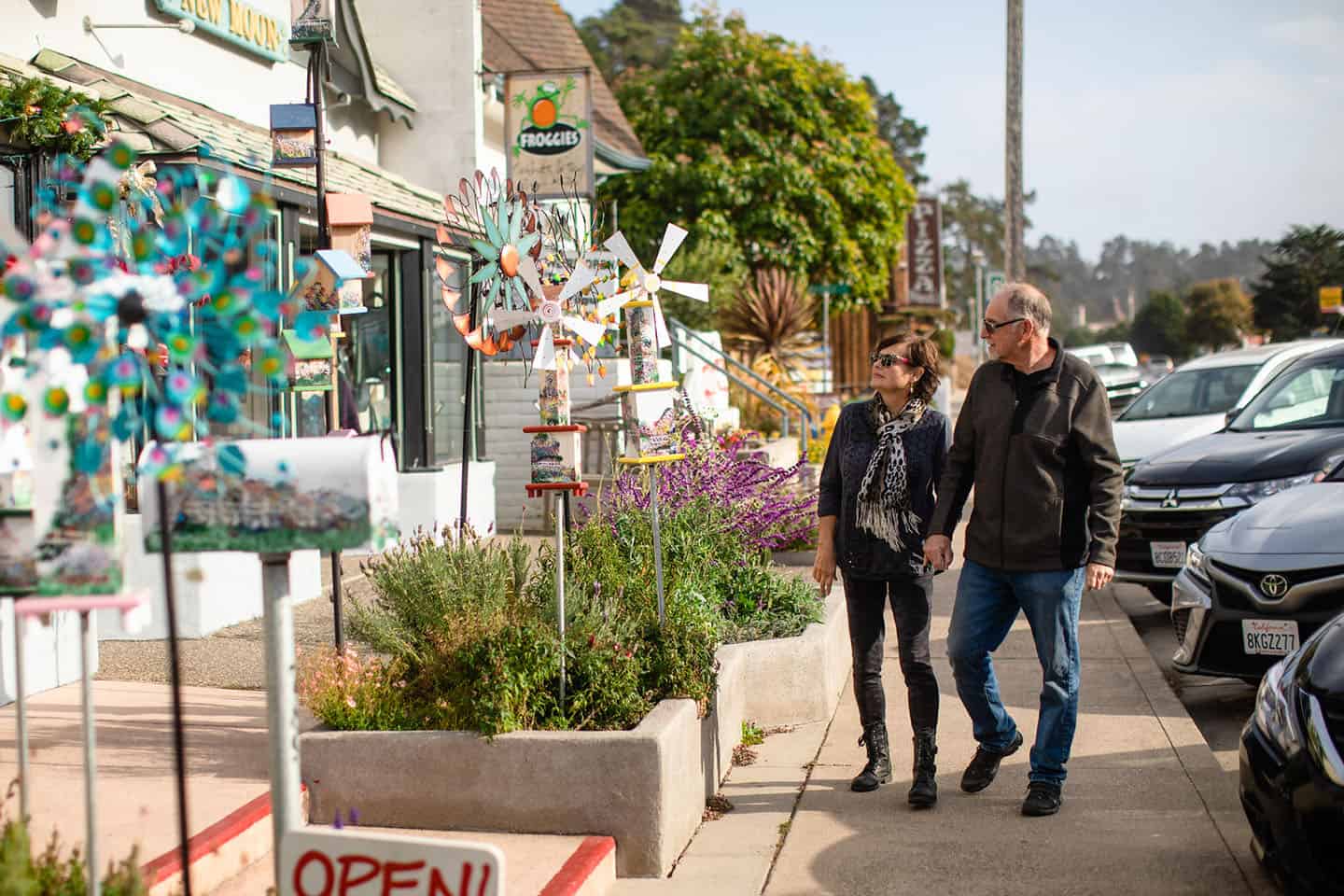
Local Dining Favorite
Linn’s Restaurant
A meal at Linn’s in Cambria is a local tradition not to be passed up. For more than four decades, Linn’s has served up comfort food inspired by the abundant flavors of the Central Coast. From sandwiches and pasta dishes to roast chicken and fresh salads, the restaurant’s offerings encapsulate the essence of the Cambria coast for breakfast, lunch or dinner. Be sure to try Linn’s renowned olallieberry pie—a must-eat treat. Additionally, Linn’s gift shop presents an array of kitchenware, jams, and finds, so visitors can bring home a culinary piece of the coast. Hungry visitors should also check out our full overview of the best Cambria dining experiences and restaurants.

Things to do in Cayucos
Estero Bluffs
Discover the unspoiled beauty of Cayucos’ Estero Bluffs along Highway 1. This untamed coastal stretch offers seaside trails, wildlife viewing and serene beaches. Conveniently located off the highway, various parking areas provide easy access for travelers. Take a short stroll to the ocean bluffs for breathtaking views. As you walk along the coast, find hidden micro-beaches just steps below. This protected state park also showcases sea stacks, tide pools, wetlands, coastal terraces and unpopulated beaches. The Villa Creek parking lot offers prime access to tucked away beach areas, while the southern end boasts an iconic beached fishing boat, accessible via the North Ocean Parking Area—ideal for a memorable photo opportunity.
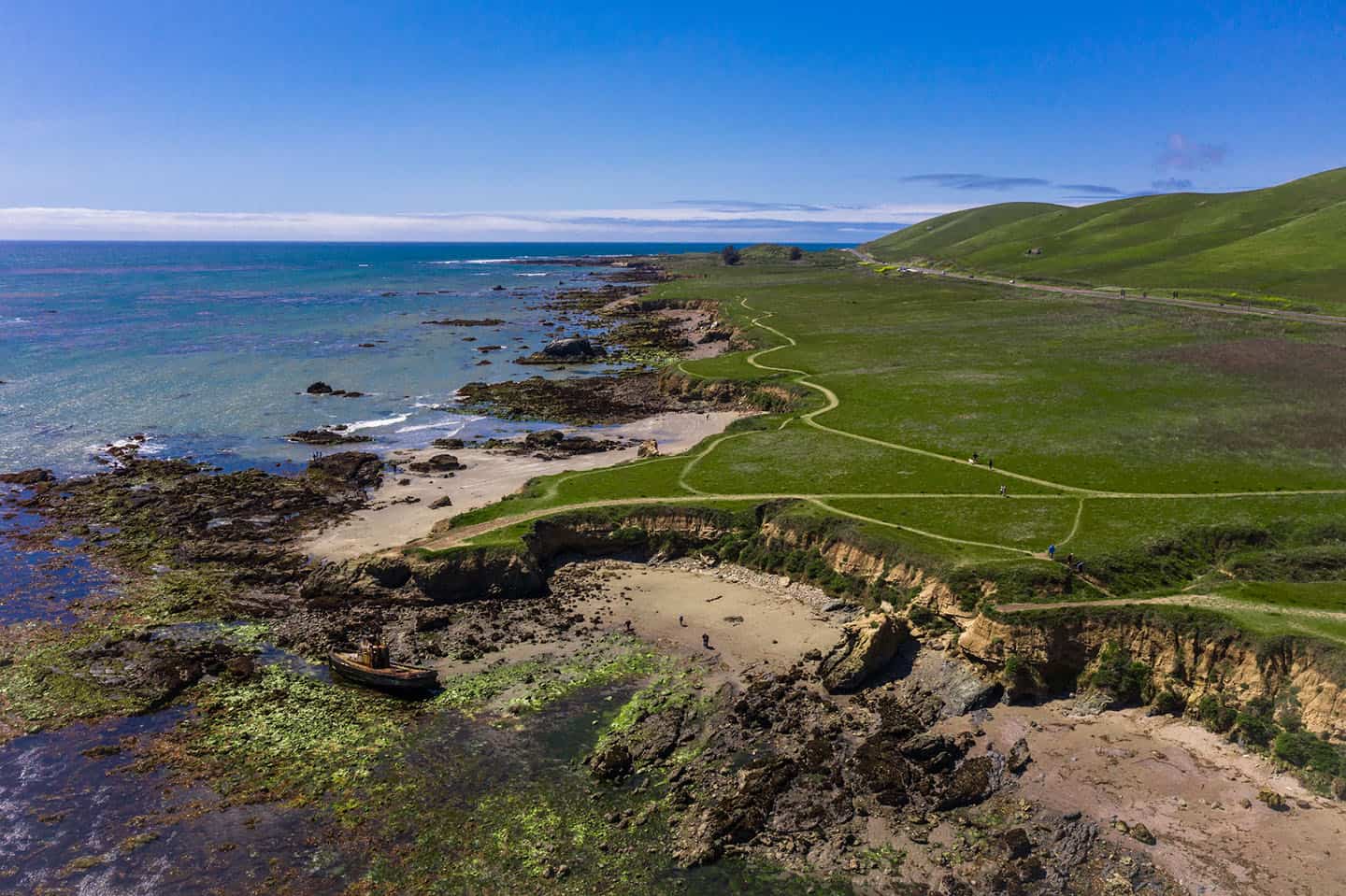
Beach Town Vibes
Cayucos captivates visitors with its rich history and quiet charm. Experience great walkability and historical significance dating back to the native Salinan people and naval captain James Cass. The heart of the town is the Cayucos Pier, surrounded by eateries, a skate park and a children’s play area. Soak up the town vibes while exploring surf shops, cafes, antique shops and historic sites. Downtown, find authentic French pastries at Bijou Bakery and famous shortbread desserts at Brown Butter Cookie Company. Before you go, be sure to admire Cayucos’ public murals, showcasing local heritage.
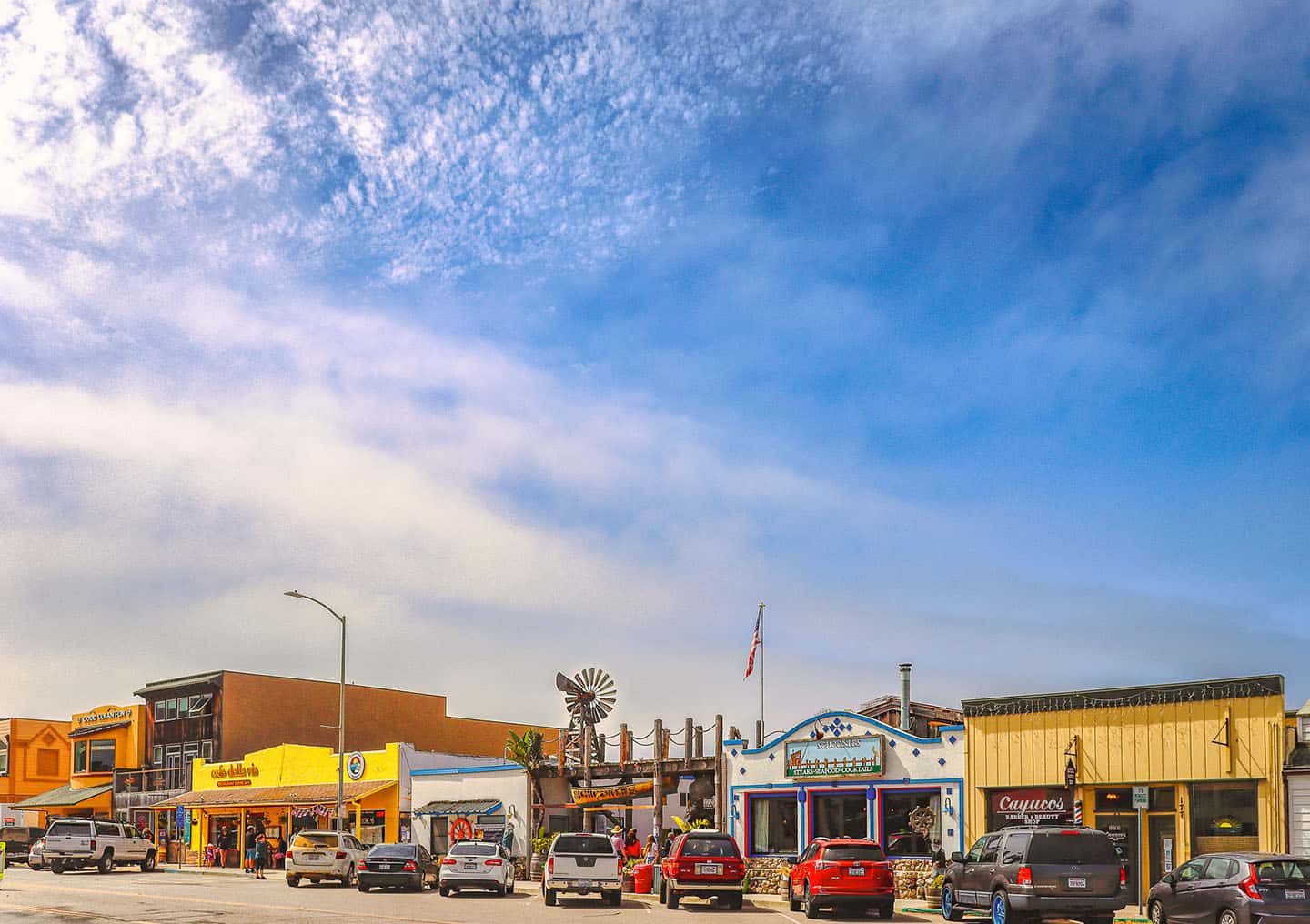
More Cayucos Adventure
Looking for more things to do in Cayucos? Check out a real life shipwreck at the Estero Bluffs, cast a line off the Cayucos Pier, or walk the mural tour. Downtown, antique stores offer up bygone treasures. For even more history, the Cayucos Historical Society Exhibit showcases artifacts, photographs and information for anyone looking to learn more or embark on a self-guided walking tour. A trip to Cayucos is incomplete without lunch at Lunada Garden Bistro, where burgers, sandwiches and steaks are enjoyed in a vibrant and historic garden area.
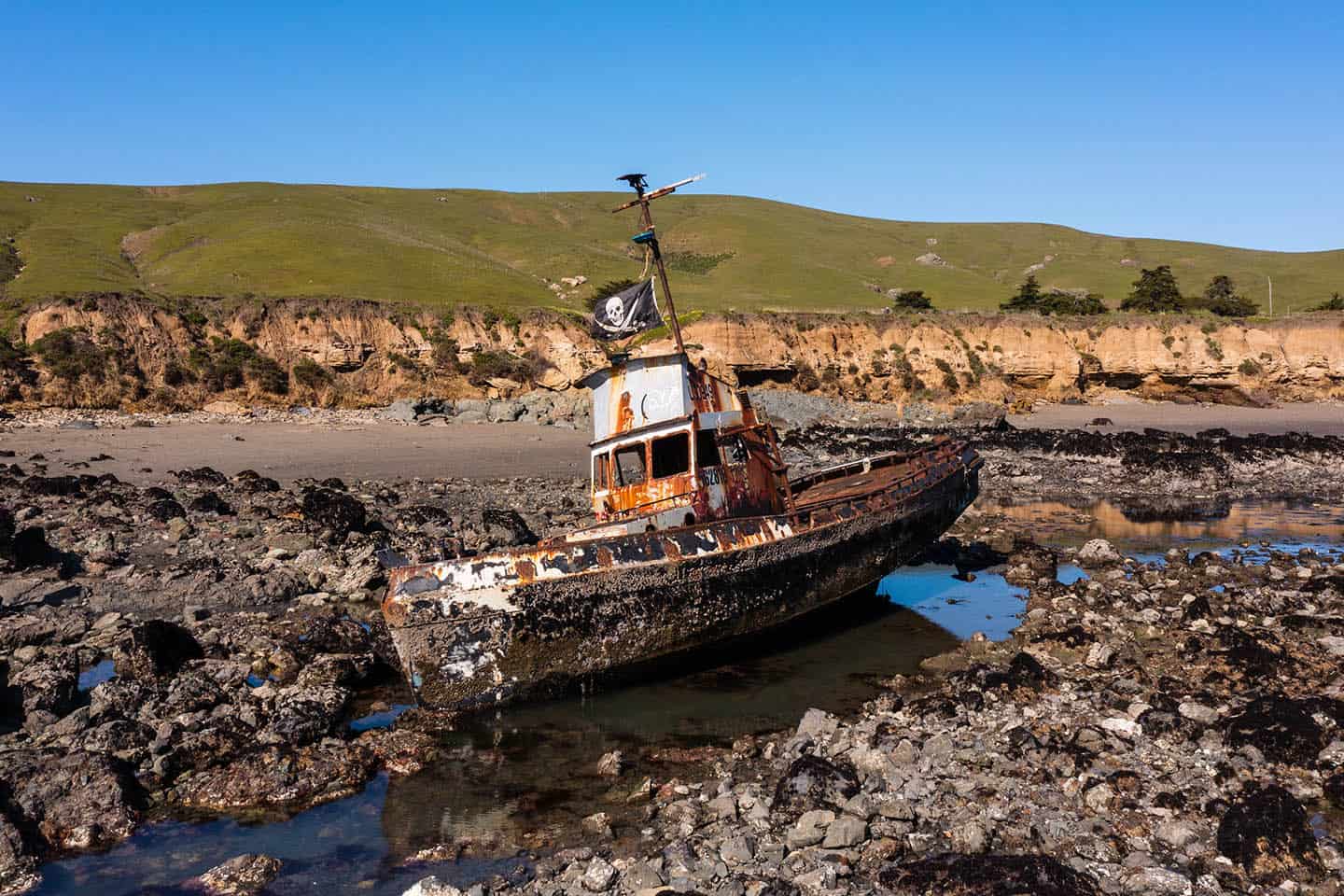
Local Dining Favorite
Hidden Kitchen
Eat a nourishing breakfast at Cayucos’ Hidden Kitchen, where the menu highlights gluten-free, organic and responsibly sourced fare. Famous for sweet and savory blue corn waffles, also find free-range egg omelets, superfood smoothies and freshly brewed coffee. Folks can relax in a cozy indoor or patio area—or opt for a beachside meal by taking the order to go. Hungry visitors should also check out our full overview of the best Cayucos dining experiences and restaurants.

Things to do in Los Osos-Baywood Park
Montaña de Oro State Park
Montaña de Oro State park offers a landscape of extremes, from lofty Valencia Peak to shoreline tidepools worthy of a day’s exploration. Tidepoolers are likely to find anemones, urchins, sea stars, crabs, limpets and more along the rugged landscape. Shells, rocks, and intriguing driftwood embellish the shoreline. Spanning several miles of coastline, Montaña de Oro offers a captivating tidepooling experience for all, from casual visitors to avid adventurers. Accessible Spooner’s Cove boasts tidepools just steps from convenient parking on Pecho Valley Road. Similarly, Corallina Cove presents easy access, requiring a brief sandy corridor stroll to reach the water’s edge. Other tidepools demand hiking along the park’s cliff trails. Regardless of your preference, these glimpses into underwater life astound with their color and diversity.
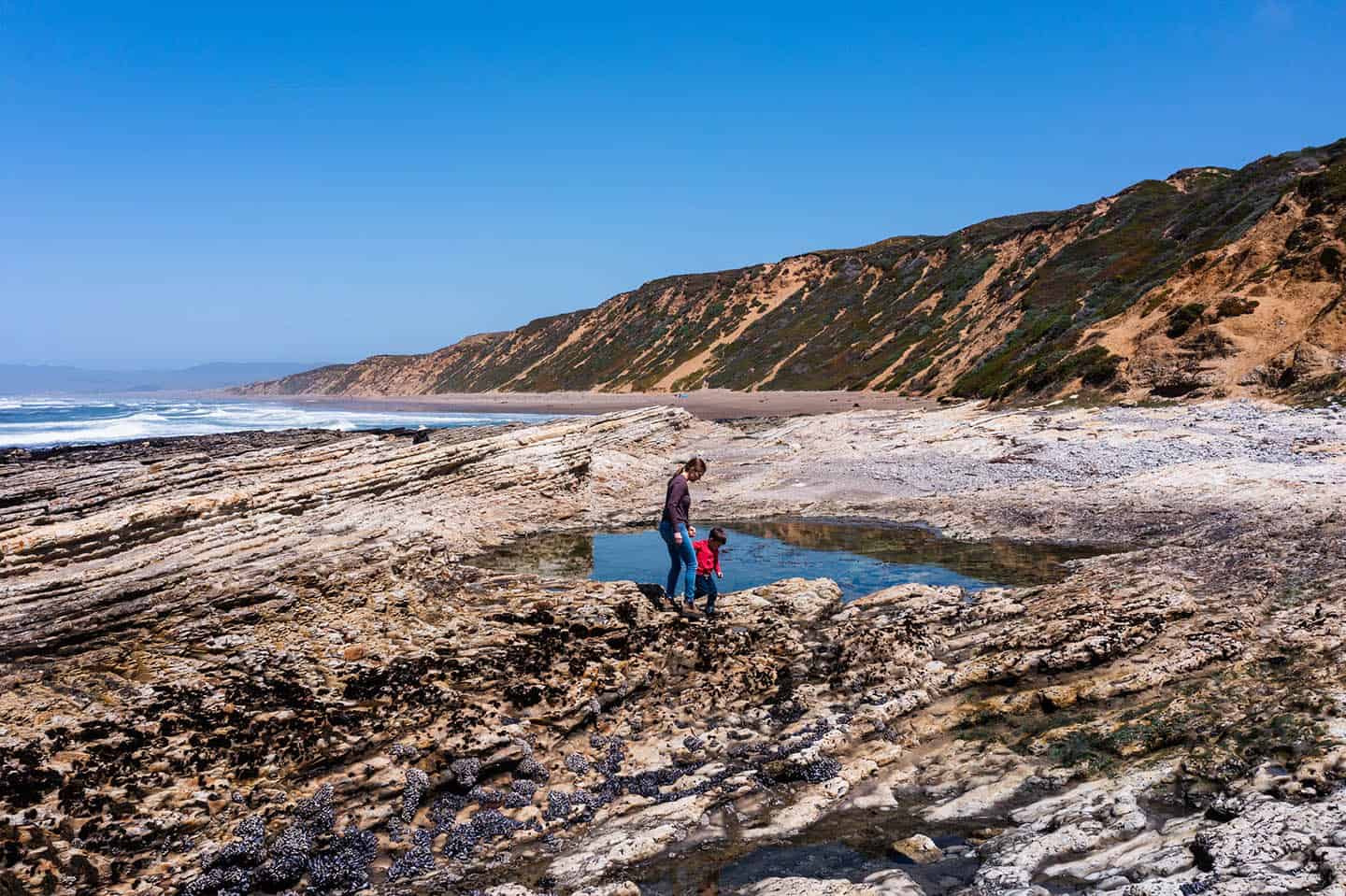
Other places to explore in Los Osos-Baywood Park
The Elfin El Moro Forest
Situated on the northeastern fringe of the back bay, The Elfin Forest is home to a grove of ancient pygmy oak trees. Unlike their towering counterparts, these oaks grow to a modest 4 to 20 feet due to the sandy soil. This location holds deep significance for the indigenous Chumash people, as evidenced by the prevalent remains of ancient disposal sites (middens). Traverse the one-mile boardwalk through The Elfin Forest leading to the wetlands of Morro Bay National Estuary. There, Bush Lupine Point and Sienna’s View decks offer prime vantage points for observing the abundant wildlife, especially birds, who benefit from the estuary’s resources. Bring binoculars or a sketchbook to fully embrace the vibrant ambiance, enriched by views of Morro Rock in the distance.
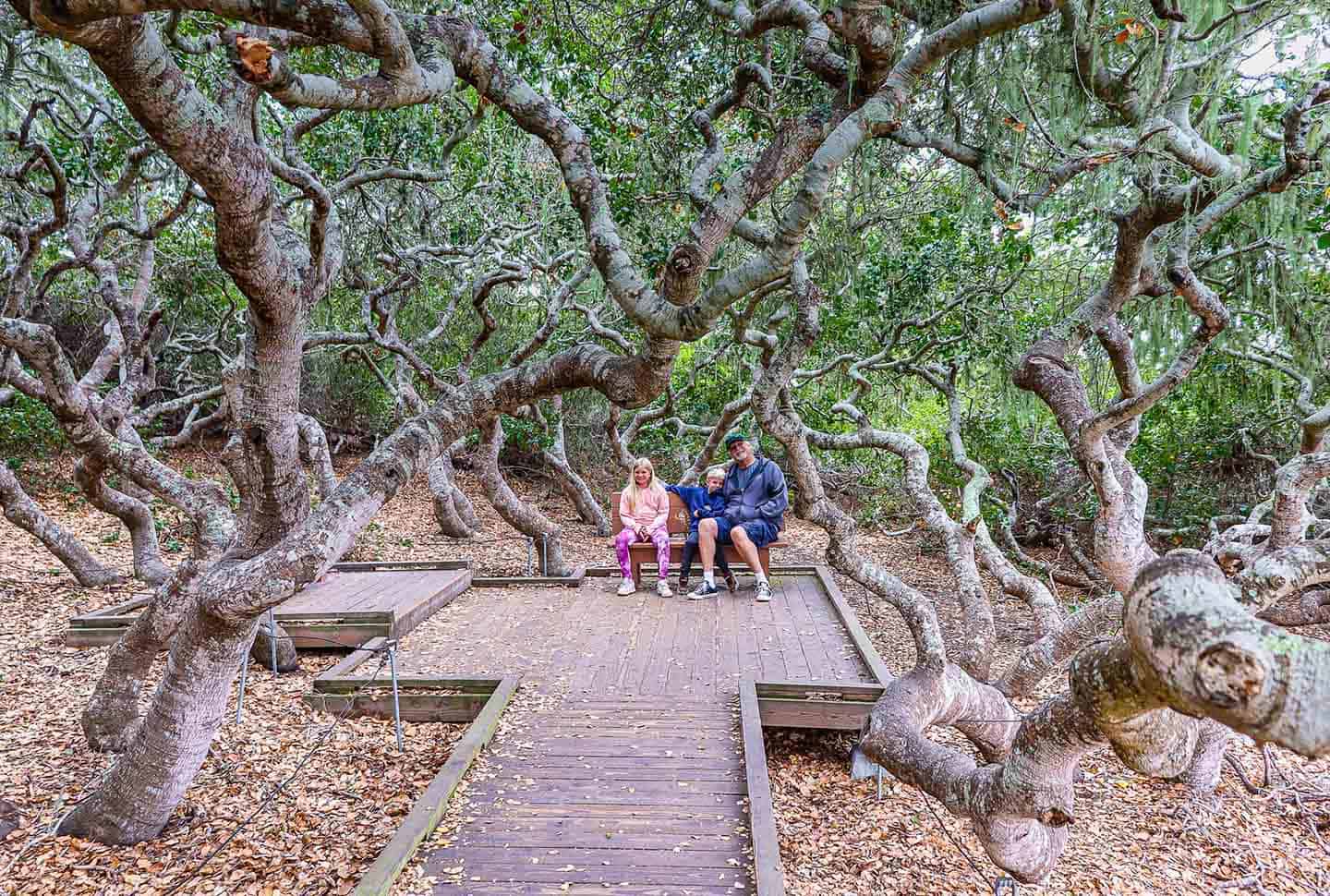
The Estuary
Established in 1996 as a federally-protected wetland, the Morro Bay National Estuary delights environmentalists and Highway 1 travelers alike. Encompassing 2,300 acres between Morro Bay and Los Osos, this cherished preserve boasts 800 acres of wetlands, including mudflats and salt marshes, providing a haven for over 250 bird species. Needless to say, this sanctuary proves a refuge for birdwatching enthusiasts, too. Wander along the Elfin Forest boardwalk to a dedicated viewing deck for a reliable vantage point or explore various hiking trails around the estuary. To experience the estuary’s wildlife up close, consider kayaking or Stand Up Paddle Boarding along the water. From the southern side near Los Osos, kayak around the estuary all the way to Morro Rock. Alternatively, enjoy the adventure of paddling within the estuary itself. Borrow kayaks and SUP boards from A Kayak Shack on the Los Osos side, ideally situated near wetland habitats and away from boat traffic. Guided kayak tours of the estuary are also readily available.
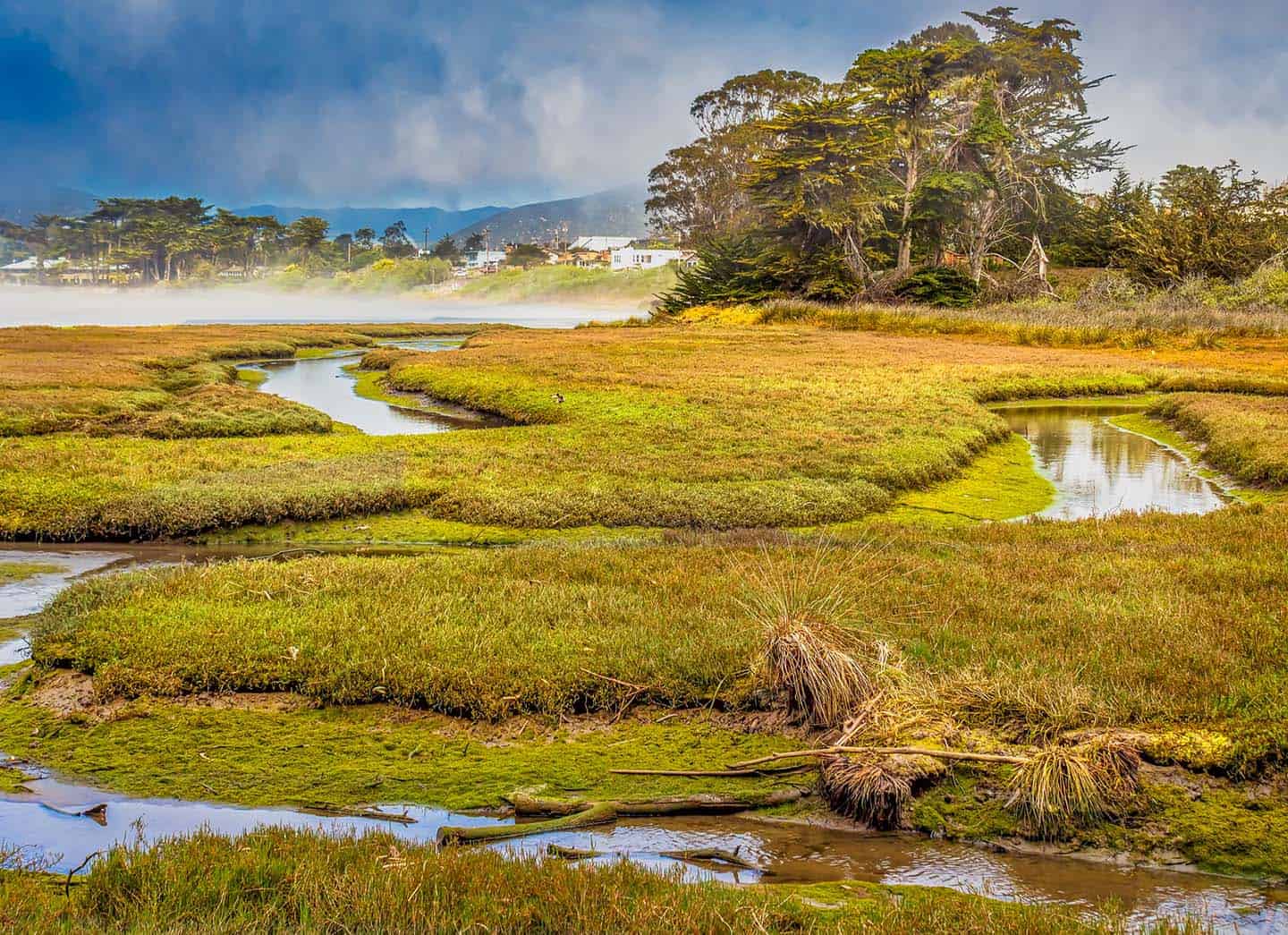
The Rock
Morro Rock is an ever-present and celebrated part of Morro Bay’s coastal landscape. This towering natural landmark is cherished by both local indigenous communities and mariners, capturing the attention of visitors to Morro Bay National Estuary and beyond. This geological marvel originates from the remains of prehistoric volcanoes. Named “El Morro” in 1542 by Portuguese explorer Juan Rodriguez Cabrillo, the rock’s crown-like form earned it this title. It concludes the sequence of peaks known as the Nine Sisters, stretching from San Luis Obispo to the coastline. Spend a day at the beach beneath this State Historic Landmark and keep an eye out for sea otters and protected peregrine falcons. Explore the south side by navigating the jetty’s rocks or relish swimming on the northside. As Morro Rock garners significant attention, consider Cayucos State Beach to the north or Spooner’s Cove to the south for more serene alternatives.
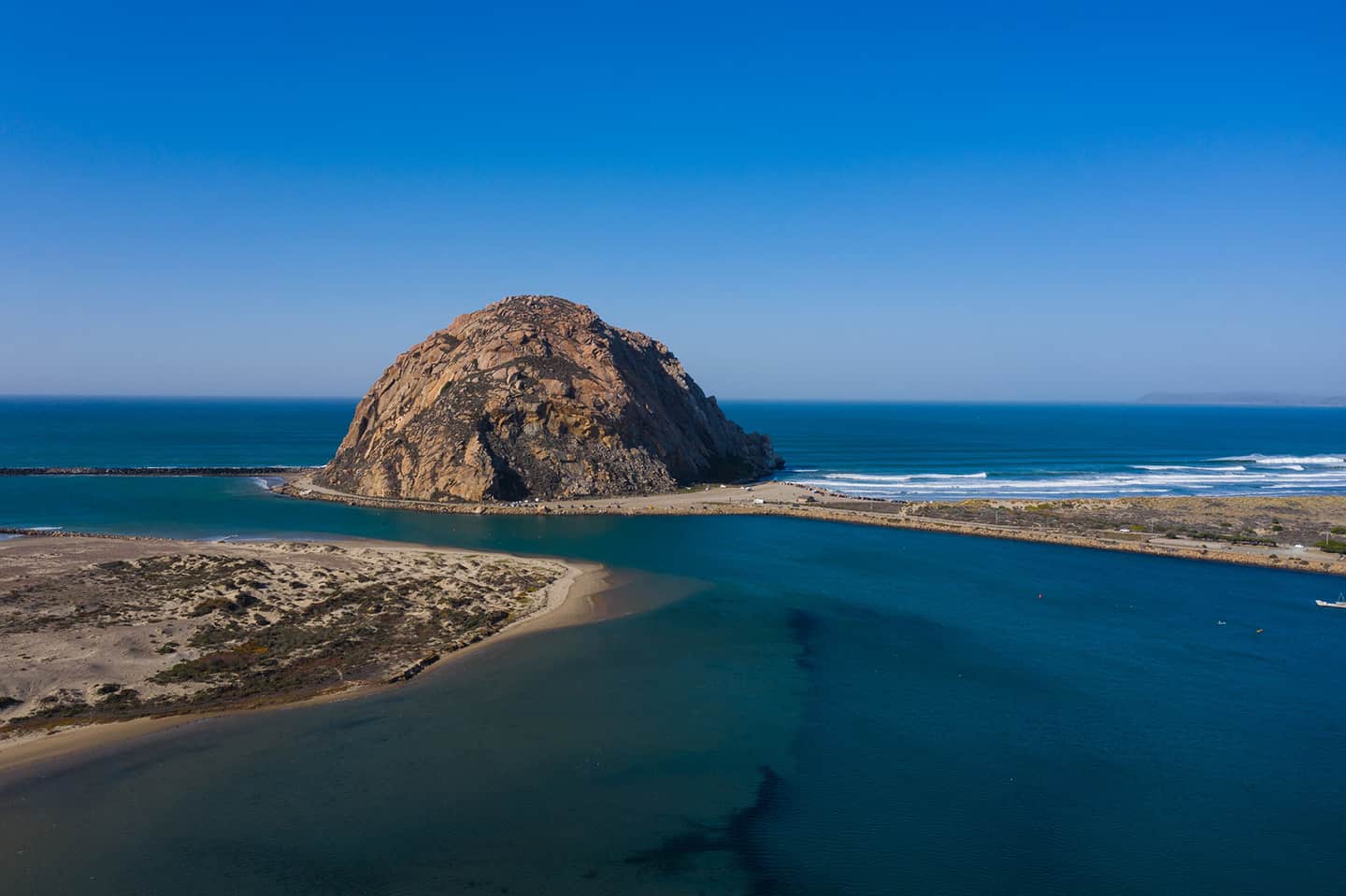
Bayside Exploring
Looking for more things to do in Los Osos and Baywood? Stop for coffee at Nautical Bean In Los Osos, home of the signature Nutty Bean java, then hit not one—but two—nearby Monarch Butterfly groves. A kayak tour of the Morro Bay Estuary is a great way to get an up-close look at local scenery and wildlife, but visitors can just as easily spend the day playing disc or foot golf at Sea Pines Golf Resort. Grab lunch at local hangout La Casita Mexican restaurant, where burritos are legendary. Visitors will also find locally-distilled spirits at Foggy Bottom Distillery.
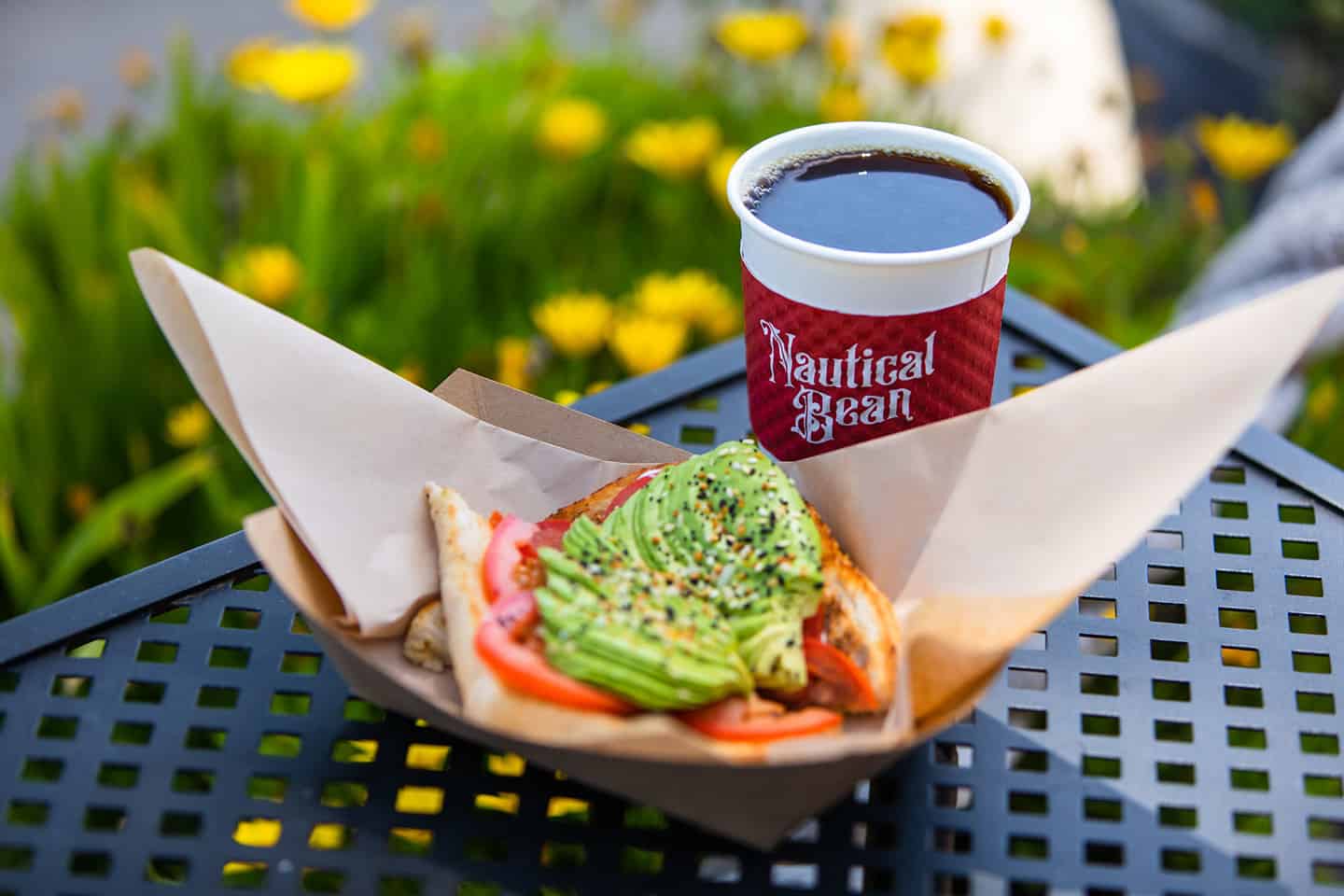
Local Dining Favorite
Kuma
Savor an Asian inspired dinner at Kuma, Los Osos’ premiere purveyor of ramen noodles in savory pork broth. Top yours with a soft boiled egg, seaweed or other fixings. That said, the teriyaki rice bowls and creative sushi rolls are also popular, especially with a side of spicy mayo. With indoor and outdoor seating, belly up to the sushi bar or invite a group of friends to enjoy a meal on the patio. Hungry visitors should also check out our full overview of the best Los Osos dining experiences and restaurants.

Things to do in Avila Beach
The Mineral Springs of Avila Beach
A premier spa experience along Highway 1, Sycamore Mineral Springs offers soothing natural indulgence. The area’s natural artesian hot springs have drawn folks to Avila Beach for over a century, including celebrities en route to Hearst Castle. Just as in the past, visitors retreat under the branches of hillside sycamore trees to soak away stress and find newfound rejuvenation. Explore signature massages, including hot stone, deep tissue, Swedish and prenatal options for individuals or couples. Facials and scrubs are also offered in a serene environment. Unwind before or after your treatment in private outdoor hot spring tubs nestled among trees. Soaks are included with every treatment and available for separate hourly rental. Each resort room also features its own hot tub, ensuring that everyone dips a toe in relaxing waters.
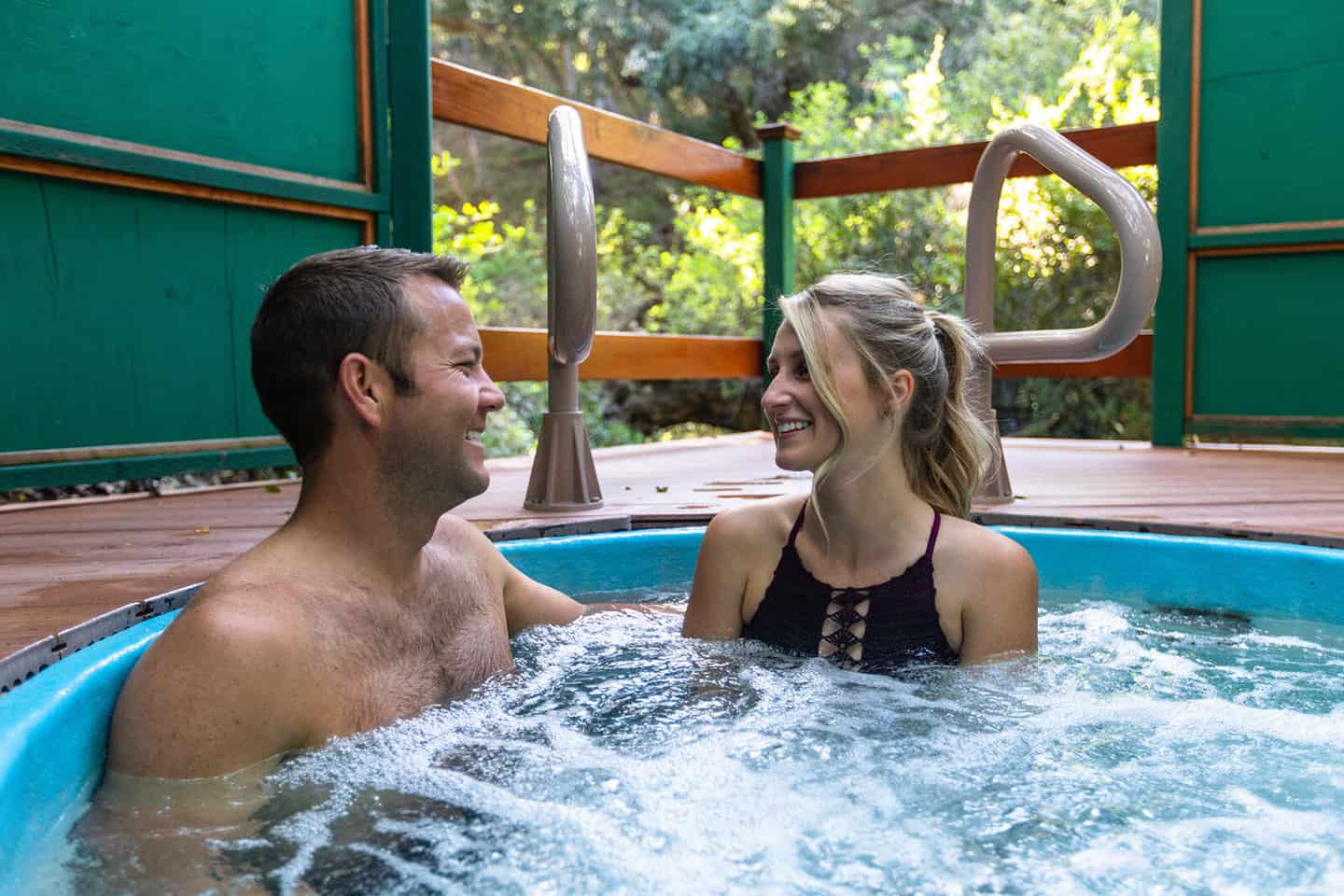
Hidden Spots in Avila Valley
Bob Jones Bike Trail & Avila Valley Barn
Trek from forest to sea on The Bob Jones Bike Trail in Avila Beach. This lovely route runs parallel to Avila Beach Drive, accommodating walkers, bicycles and non-engine vehicles. Extending about 3 miles roundtrip, this flat, paved path begins at Ontario Road and culminates at Avila Beach. A bridge connects the trail directly to Sycamore Mineral Springs, making it convenient to rent resort bikes and pedal to the beach. For an added adventure, visit Avila Valley Barn at Avila Beach Drive and Ontario. This operational farm offers seasonal “U-Pick” options including pumpkins, apples, blackberries, apricots and more. Delight in hayrides to the fields, pick your produce and explore the barn’s treasures, from pies to preserves. The barn also offers an extensive range of produce, canned goods, smoked meats and nearby hot barbecue offerings. An old-fashioned candy shop and an impressive selection of children’s toys and books make this a family-favorite stop.

Whale Watching
Avila Beach offers prime opportunities for whale sightings, allowing visitors to witness the grace of these majestic creatures in their natural habitat. The optimal time for whale watching in Avila Beach is during the migration seasons: Gray whales can often be spotted from December to April as they travel along the California coast during their annual migration. Humpback whales and blue whales are frequently seen from June to September, adding to the excitement of the whale watching experience. To ensure the best chances of sightings, consider planning your visit during these migration windows. Visitors will also want to check out the Whale Trail for even more whale watching tips and stops all along Highway 1.
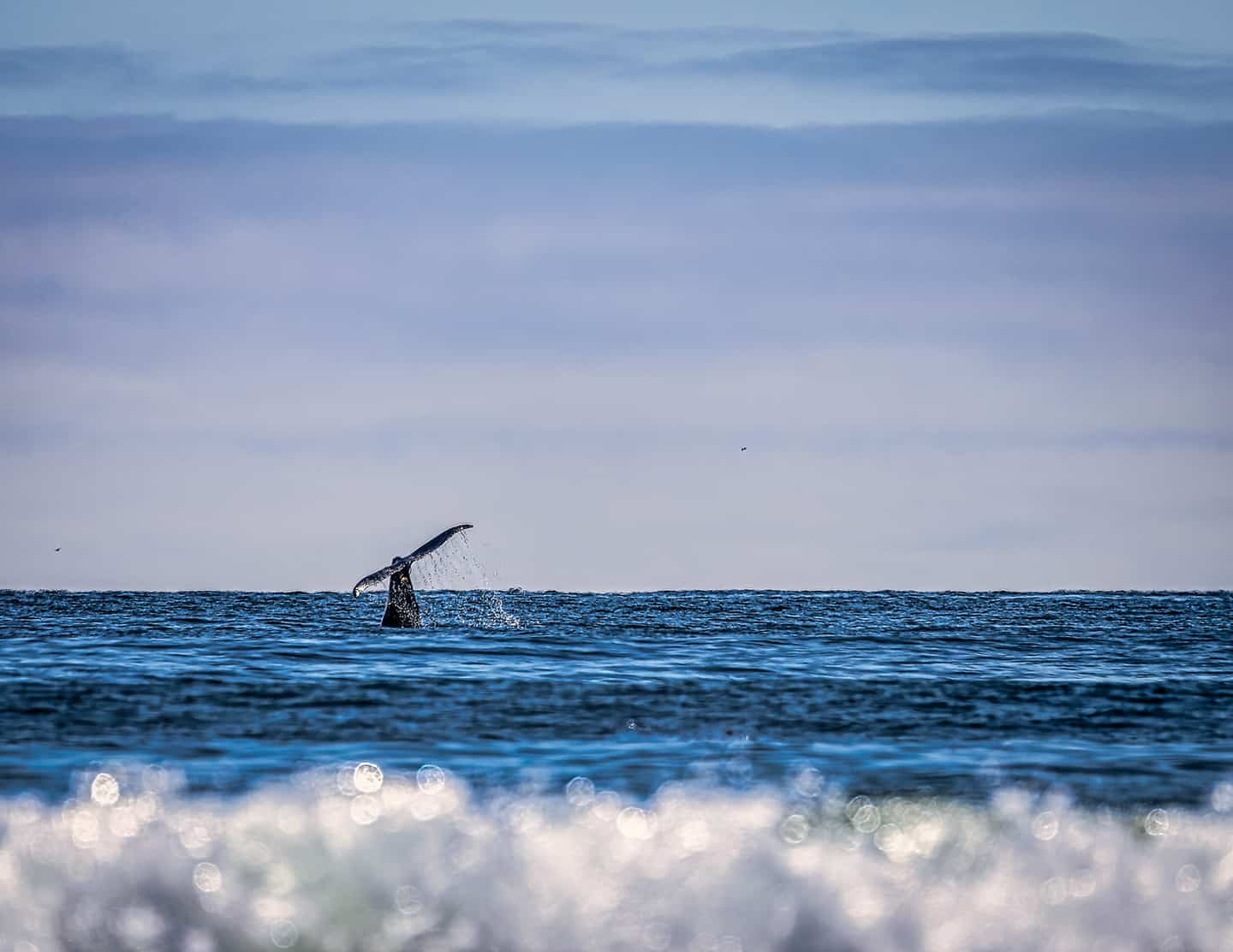
More Avila Beach Adventures
Looking for more things to do in Avila Beach? Hike from the caves to the ridge when you embark on a hike through Avila Beach’s coastal trail offerings. Hit the water and Stand Up Paddle Board along this beach community’s three historic piers, stopping to grab lunch from Mersea’s on Harford Pier, home of great seafood and cocktails. Visitors can also enjoy a romantic sunset dinner at Ocean Grill, where classic Italian cuisine is crafted with farm-fresh local ingredients. Plus, a morning pick-me-up can always be found at Avila Promenade, where Kraken Coffee Company offers espresso drinks and pastries.
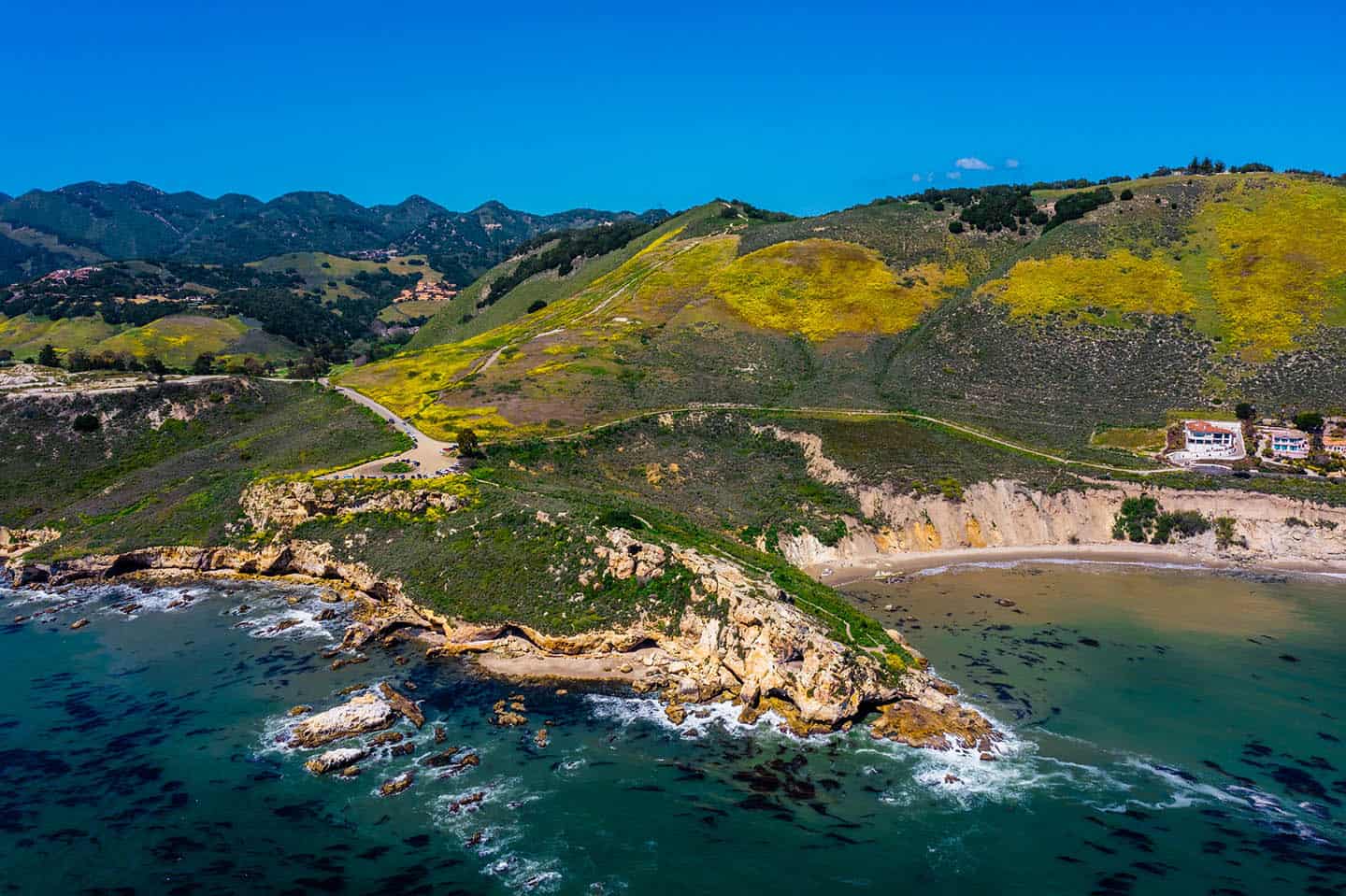
Local Dining Favorite
Blue Moon Over Avila
Indulge in exquisite French flavors and breathtaking oceanfront views at Blue Moon Over Avila in Avila Beach. Inspired by European eateries, this oceanfront wine Bar and French-style bistro offers up a sophisticated dinner menu paired with wines from around the world. Sample expertly prepared French dishes—including fine cheeses, escargot and ratatouille—for a memorable gastronomic journey on the Pacific.
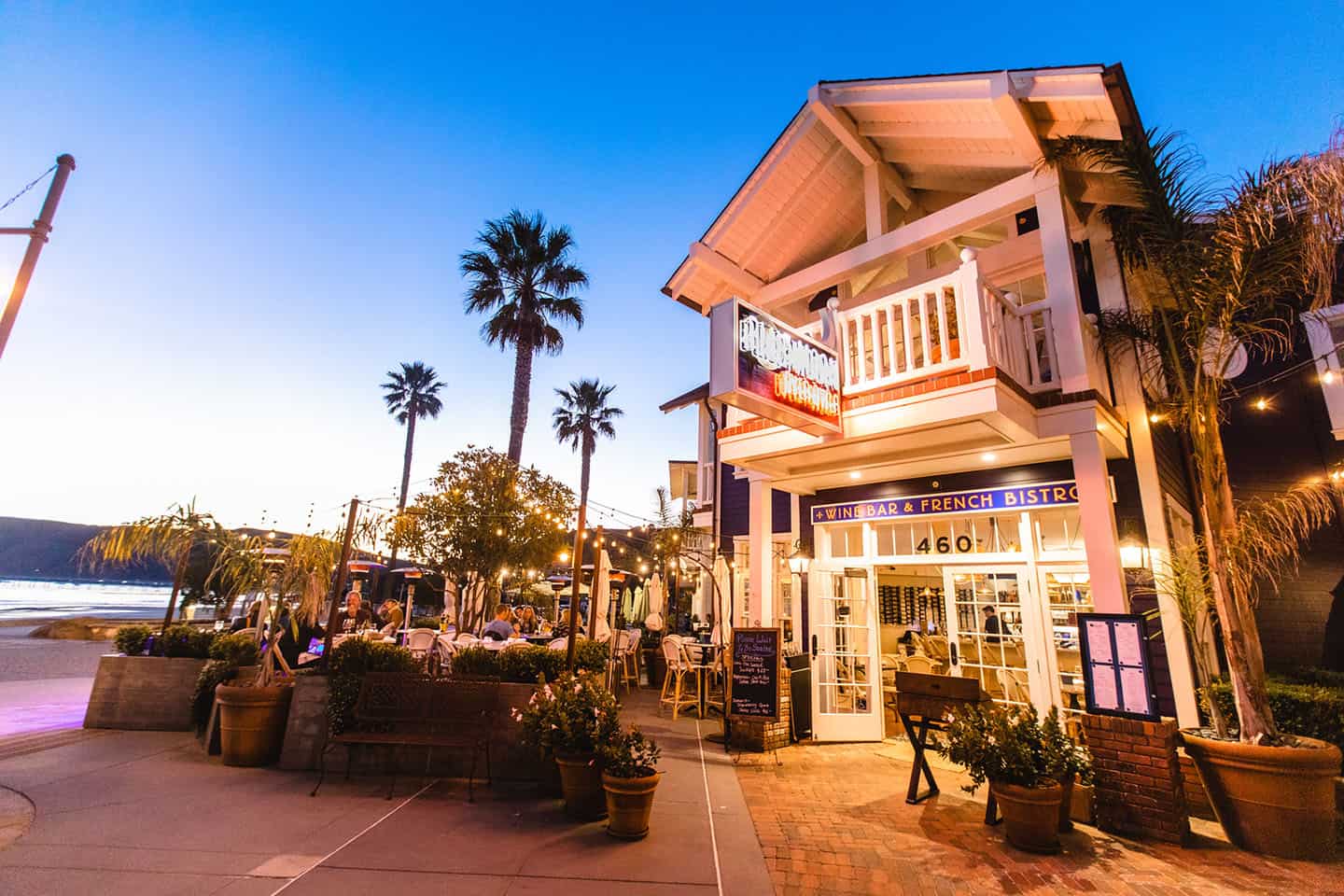
Things to do in Edna Valley
The Wine Trail of Edna Valley
Bask in Edna Valley’s scenic landscape, where sea meets vine. A few miles from the Pacific Ocean, find over two dozen family-owned wine tasting rooms, conveniently situated along Highway 227 and Orcutt Road. Sample the region’s famous pinot noir and chardonnay offerings, among other cool-climate wine varietals. The longest growing season in the state coupled with a sunny valley capturing coastal fog and marine air makes for supremely balanced wines. Unlike the warmer climes of Paso Robles, Edna Valley’s coastal weather provides an ideal environment for laid back tasting.
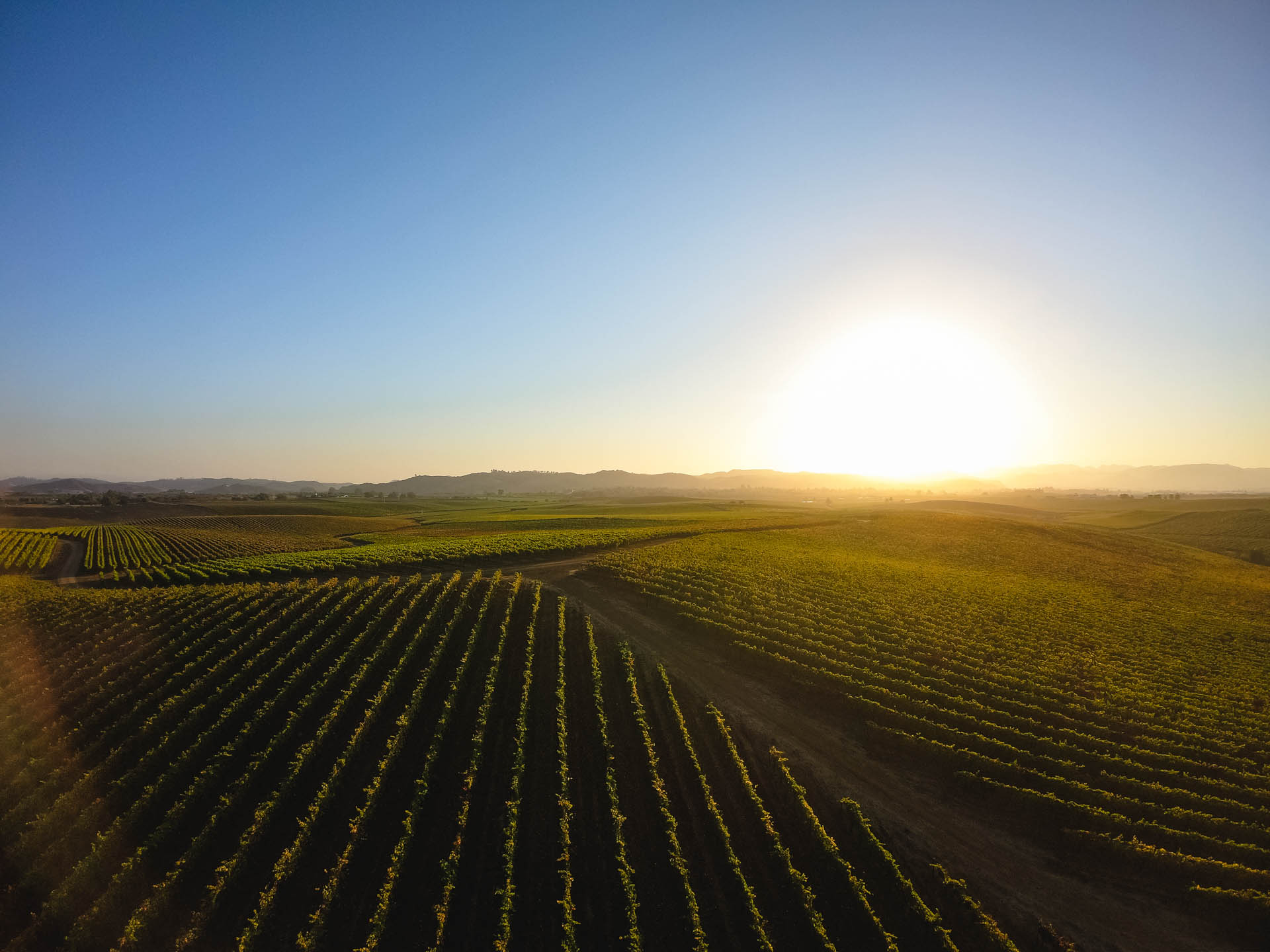
Our Top Tasting Room Picks
Baileyana
An integral part of the Edna Valley wine scene since the 1970s, Baileyana winery is a must-visit wine tasting room. Visitors can sample four distinct brands at this relaxed locale: True Myth, Zocker, Tangent, and Baileyana itself. These labels are a testament to the Niven family’s multi-generational dedication to refining their farming and winemaking expertise. Baileyana excels in showcasing Edna Valley’s finest, with an emphasis on chardonnay, pinot noir and cool climate syrah. True Myth delivers cabernet sauvignon, chardonnay, and red blends from nearby Paso Robles. Tangent is renowned for cool-climate white varietals like sauvignon blanc, albariño, and pinot gris. Zocker, meaning “gambler” in German, produces grüner veltliner cultivated in Edna Valley. The tasting experience unfolds within the old Independence Schoolhouse, built in 1909. Here, tasters can enjoy picnic areas, bocce ball court and panoramic views of the Santa Lucia Mountains.
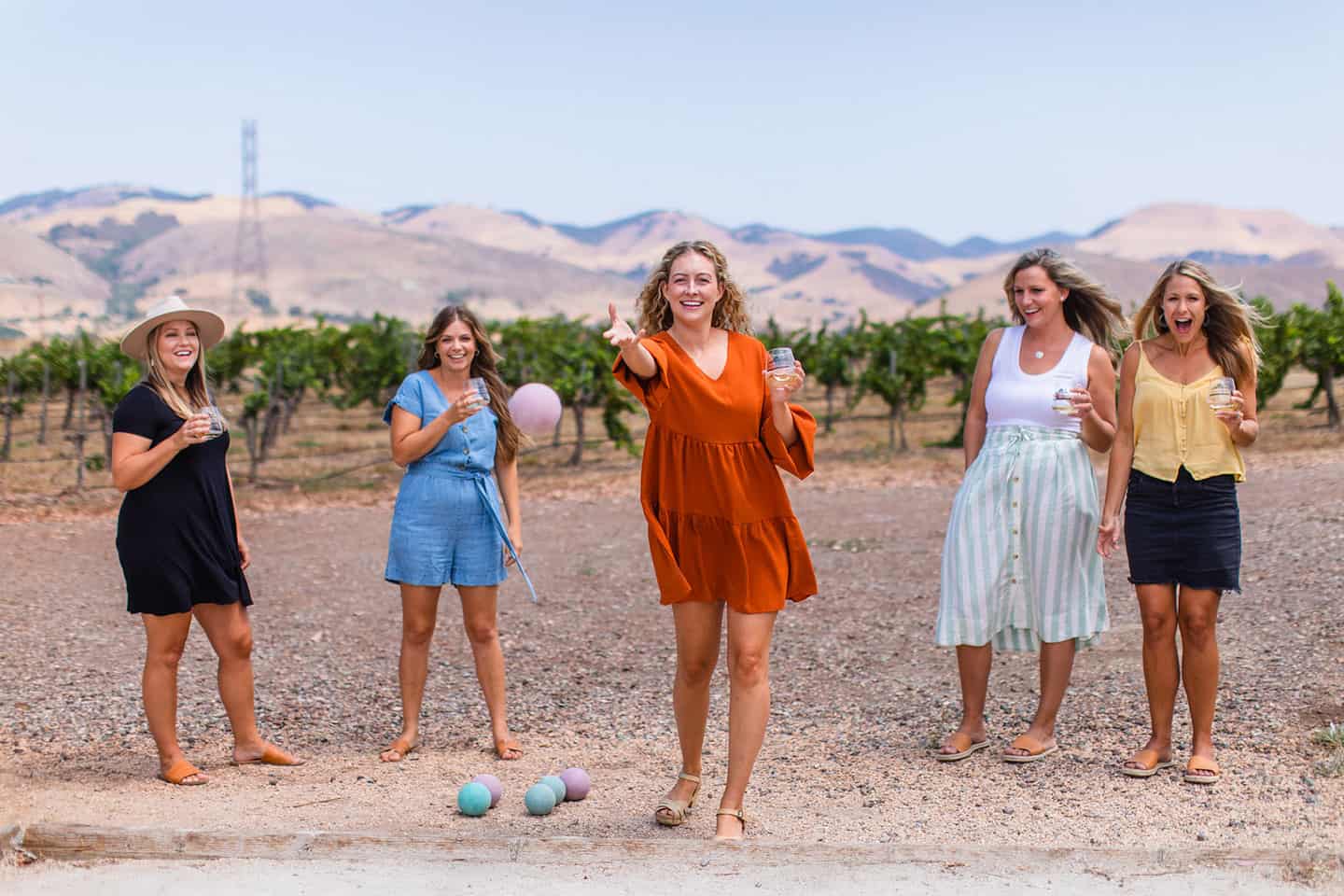
Edna Valley Vineyard
Situated along the historic Biddle Ranch Road in Edna Valley, Edna Valley Vineyard stands as a pioneering winery in the region. Originally established by the Niven Family and later acquired by Gallo Wines, the legacy of Edna Valley Vineyard’s exceptional chardonnay endures today. The charming tasting room continues to offer picturesque vistas, allowing visitors to enjoy wines crafted from the very vines visible through its windows. Select from a range of well-balanced, food-friendly wines boasting the distinctive Edna Valley acidity. The winery provides various tasting experiences, including the 18 Barrel Flight featuring five limited release wines. The Heritage Flight offers a seated tasting of five limited release wines artfully paired with fine cheeses. During summer, partake in “Happier Hours” on Fridays accompanied by live entertainment.
Tolosa Winery
Decades ago, a young rancher acquired land in Edna Valley for cattle grazing. Captivated by the cool climate, he transformed the land into vineyards and a winery. Today, Tolosa Winery is known for producing exceptional chardonnay and pinot noir. The tasting experience at Tolosa is an opulent affair, offering seated tastings both indoors and outdoors. A standout is the Barrel Tasting, allowing guests to preview wines pre-bottling. The 1772 tasting showcases five signature Tolosa wines, while the Perinet Experience introduces wines from Tolosa’s sister winery in Spain, Perinet. This unique experience delves into the terroir, culture, and traditions of the Priorat region. Guests can also indulge in Spanish cheese and charcuterie pairings during the Perinet tasting.
Edna Valley Adventures
Looking for more things to do in Edna Valley? Head to nearby Lopez Lake in Arroyo Grande for lakeside action, including boating, camping and water park play. Along the way, stop for farm stands and historic stops. In the heart of downtown Arroyo Grande, find the ancient Swinging Footbridge and time-honored one-room schoolhouse.
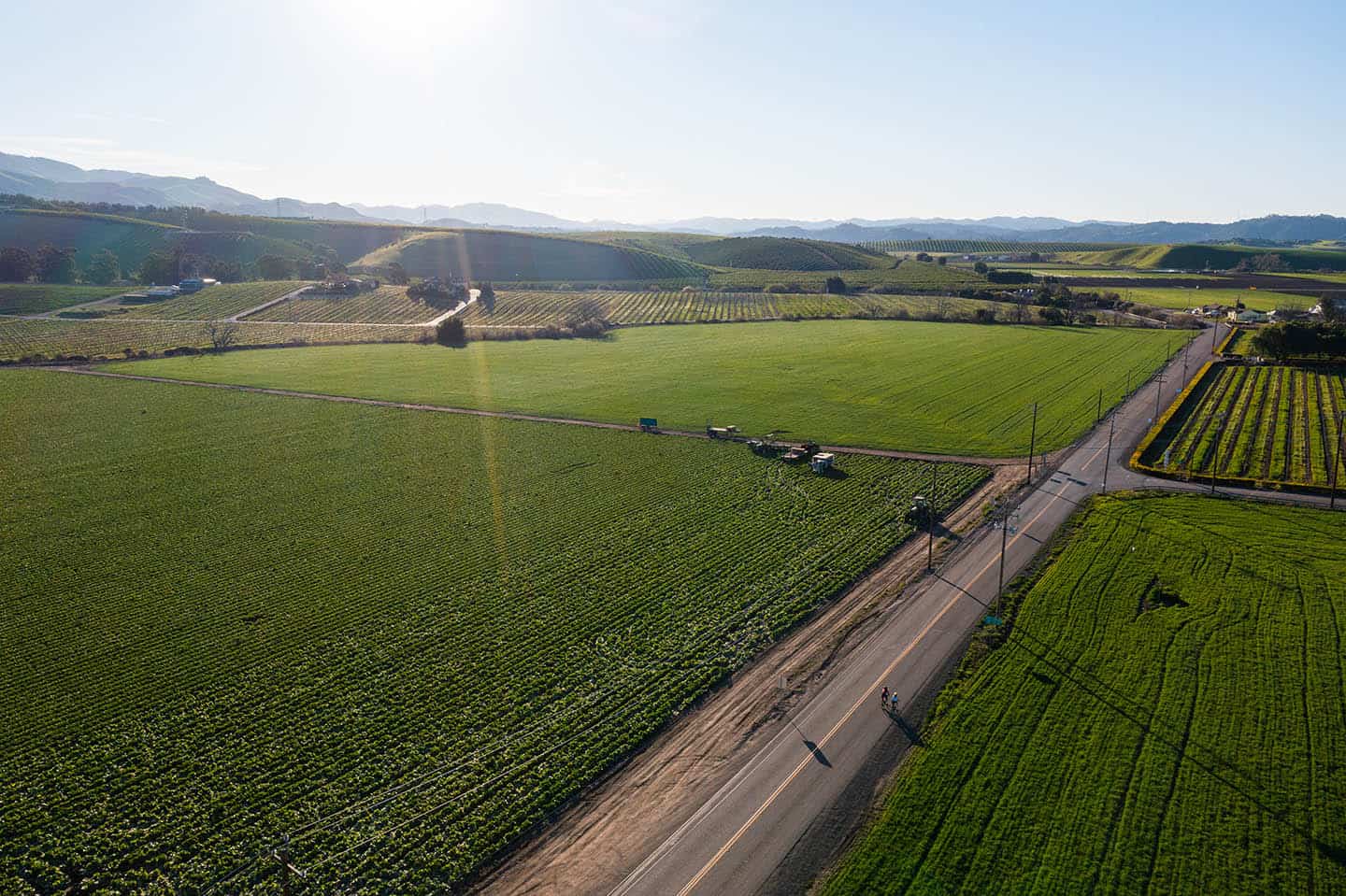
Things to do in Arroyo Grande
The Adventure Park of Arroyo Grande
Elevate any Highway 1 adventure at Vista Lago Adventure Park in Arroyo Grande. Situated within Lopez Lake State Recreation Area, this park promises an exhilarating test of wits, stamina and reflexes. Engage in multiple rope challenge courses, including the Squirrel Zone, Quail Trail, Deer Run and Black Bear course—each one progressively more demanding. For younger participants, the Cub Course offers a ground-level exploration with added safety measures. Dive deeper into the experience with the All-Access Guided Tour or Agility Guided Tour, unveiling the full spectrum of Vista Lago’s challenges. Alongside the rope courses, an exhilarating zipline park boasts three lines spanning 1,800 feet. Thrill-seekers won’t want to miss The Ledge, a heart-pounding 45-foot freefall. Before or after your adventure, unwind on the viewing deck, enjoy games and relish on-site food and beverages.
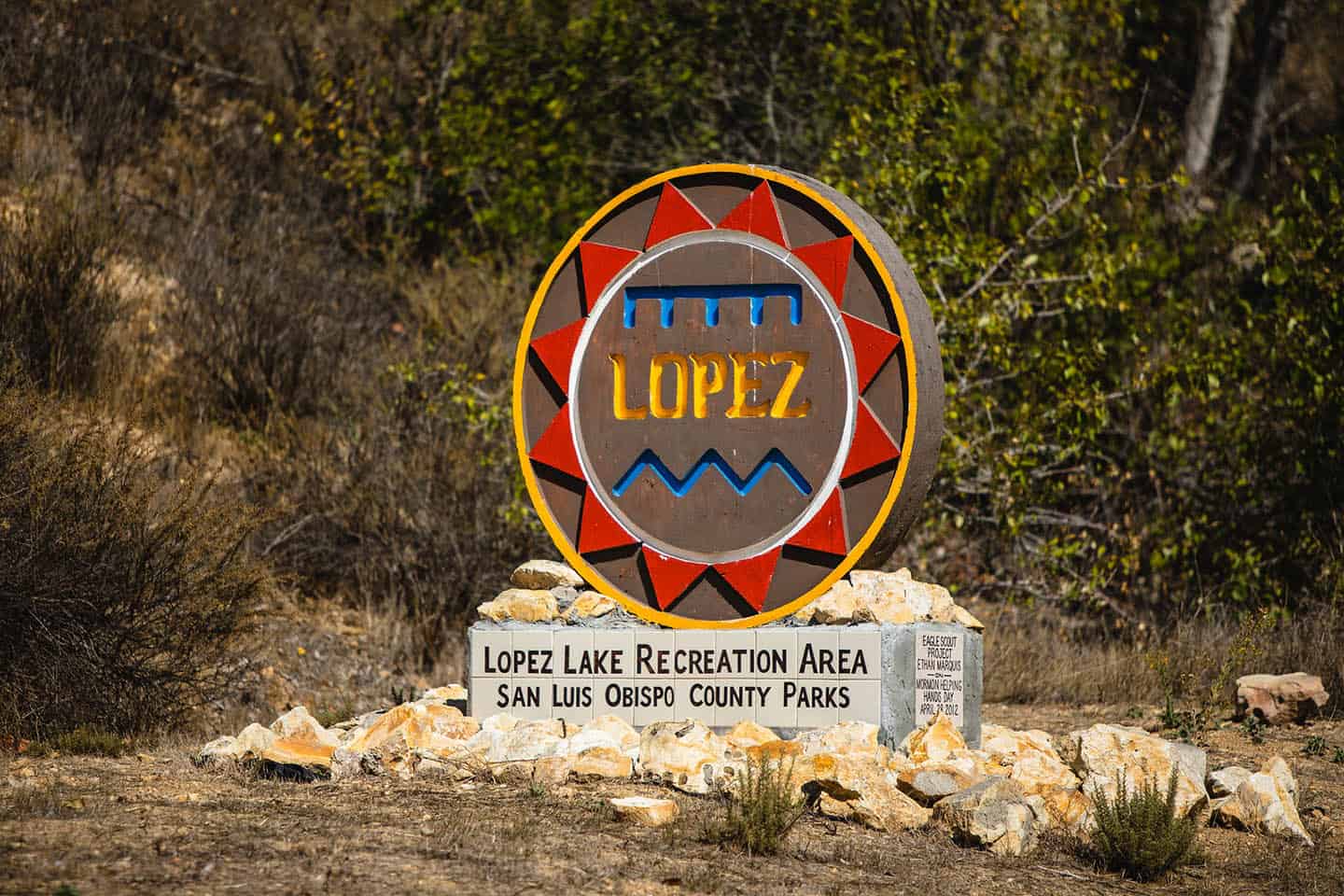
Lopez Lake & Mustang Water Park
Nearby Vista Lago Adventure Park, find endless lakeside fun. Discover the expansive Lopez Lake State Recreation Area, spanning 4,200 acres of open space and trail networks. This natural playground is highlighted by the picturesque Lopez Lake, boasting a 22-mile shoreline and encompassing 450 acres. Renowned for boating and fishing, the lake is a winter haven for stocked rainbow trout, while catches of largemouth bass, bluegill, and red-eared sunfish prove popular year-round. Whether you choose to fish from the dock, along the shore, or venture into the heart of the lake with a rented boat, the options are as diverse as the catches themselves. For a dynamic experience, explore wave runners, jet skis or even a canoe, all available to rent. Visitors can also delve into aquatic thrills at Mustang Water Park, nestled within the state recreation area. This park boasts two exhilarating 600-foot water slides cascading into a sparkling swimming pool, along with the Stampede half pipe slide, a kiddie pool, cabanas and a snackbar.
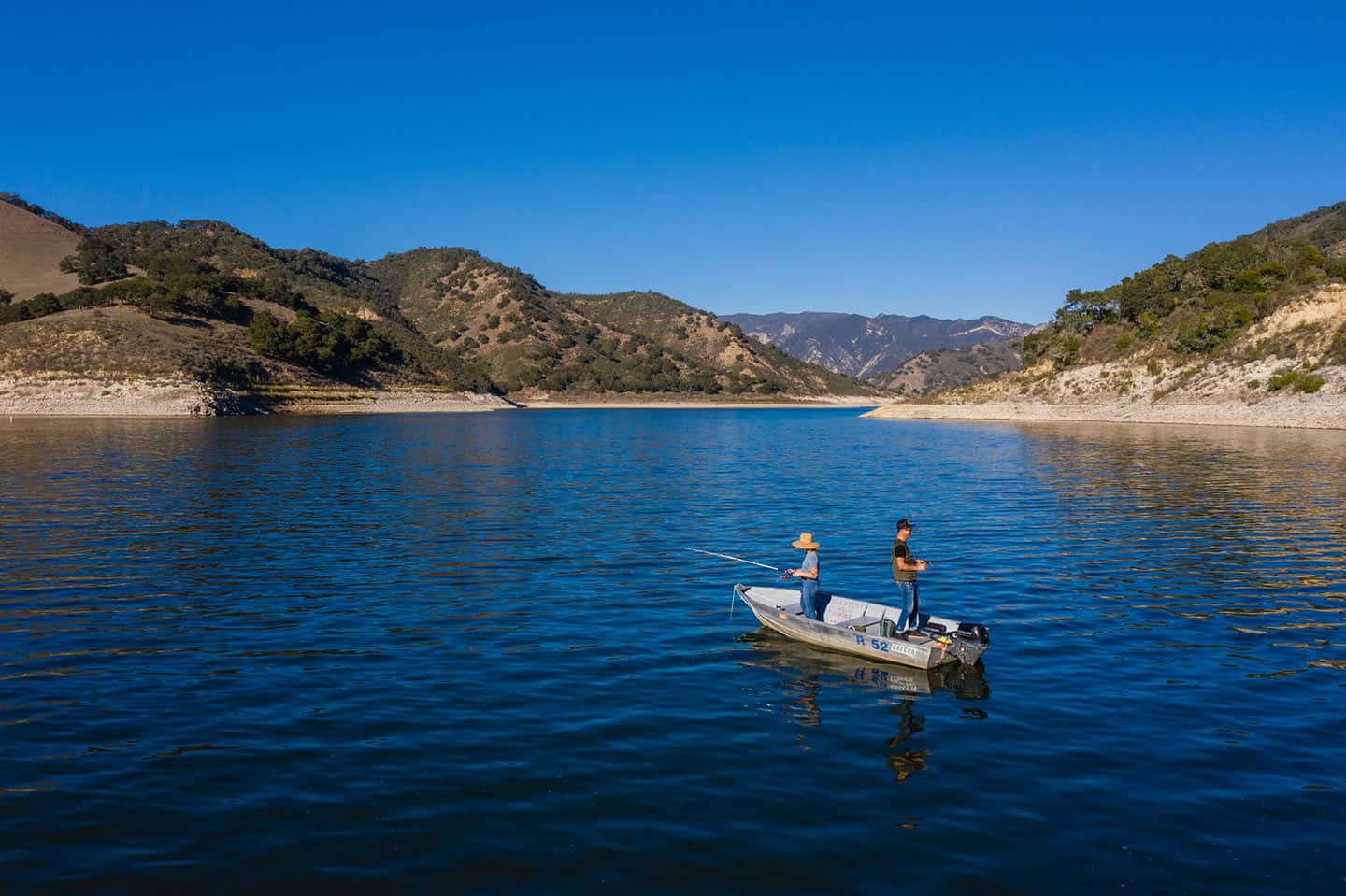
More Arroyo Grande Adventures
Looking for more things to do in Arroyo Grande? Stroll the charming Arroyo Grande Village, where antique shops, restaurants and boutiques beckon. Take in a show at the Clark center, where national and local acts converge, or enjoy a wine tour of Edna Valley’s chardonnay and pinot noir offerings. Whether you hit a local farmstand or check out historic fun on the History and Heritage Trail, visitors will find a dynamic family-friendly destination.
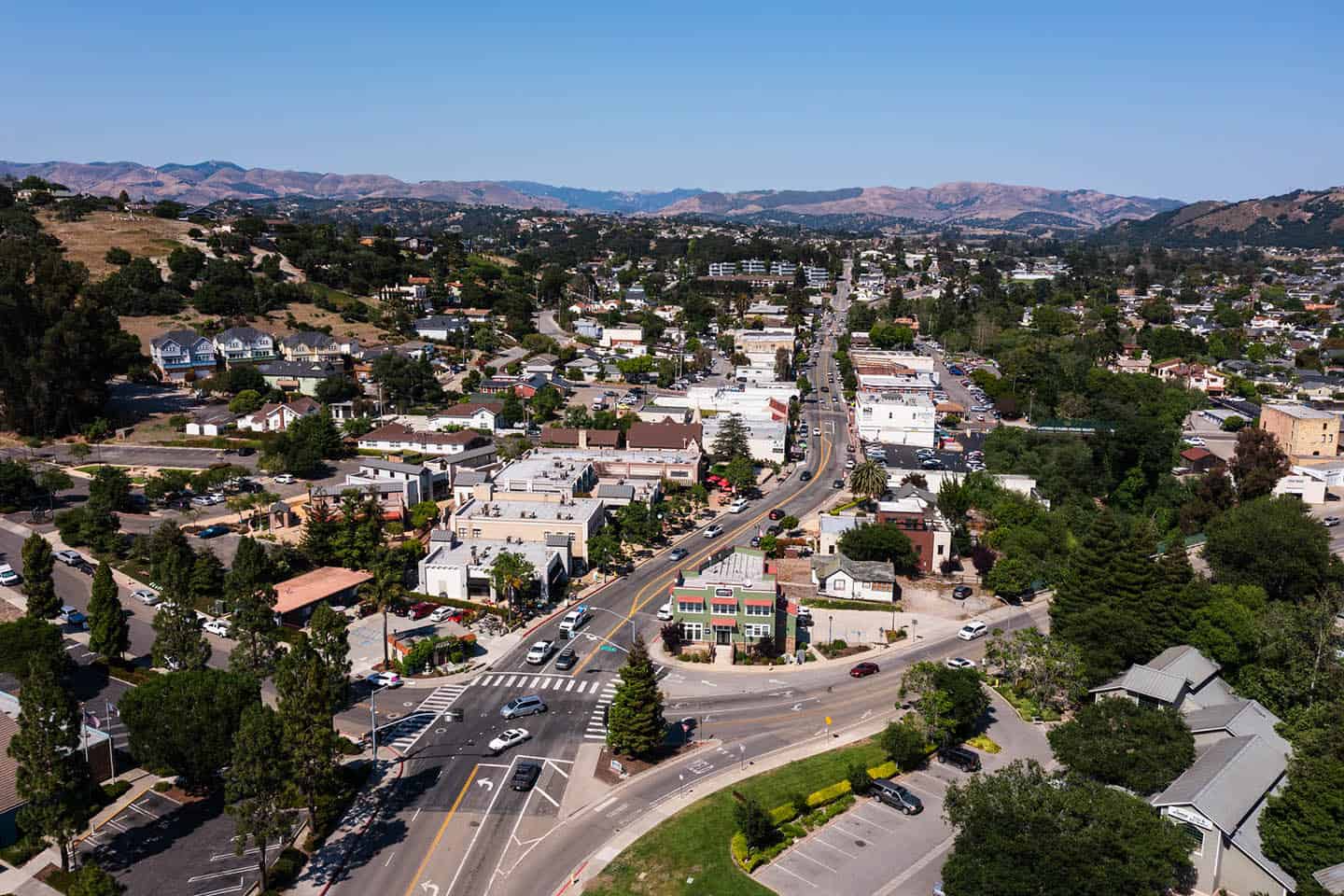
Local Dining Favorite
Ember
A favorite of foodies far and wide, Arroyo Grande’s Ember offers a rustic-Italian culinary experience to remember. This cherished eatery is known for its inventive wood-fired pizzas, captivating entrees and salads brimming with fresh, local elements. Discover elevated flavors accompanied by warm hospitality and an expansive drink selection featuring fine wines, local craft beer and expertly crafted cocktails. Be sure to leave space for dessert, too. Hungry visitors will also want to check out our full overview of the best Arroyo Grande dining experiences and restaurants.

Things to do in Pismo
The Pismo Preserve
Hike the Pismo Preserve, where the breathtaking ocean view spans Point San Luis to Point Sal. This expansive 880-acre preserve presents 11 miles of versatile trails catering to hikers, mountain bikers and equestrian enthusiasts of all ages. Previously utilized as grazing land for generations, a collaboration with The Land Conservancy has preserved its legacy while aiding fire prevention. Visitors can explore this incredible landscape by foot, hop on a mountain bike, or saddle up on a horse. Behold sweeping sights of the Nipomo and Oceano Dunes towards the west and captivating wine country scenery to the east. Abundant wildlife enhances the experience: deer, coyotes, sea birds, snakes, squirrels and even distant offshore whales might be spotted by visitors. For a peek into the lives of local critters, explore the Wildlife Camera Project, a live camera that captures animals in action. Situated on the east side of Highway 101 in Pismo Beach, the Pismo Preserve offers accessible parking featuring ADA amenities, a picnic area and equestrian trailer accommodations.
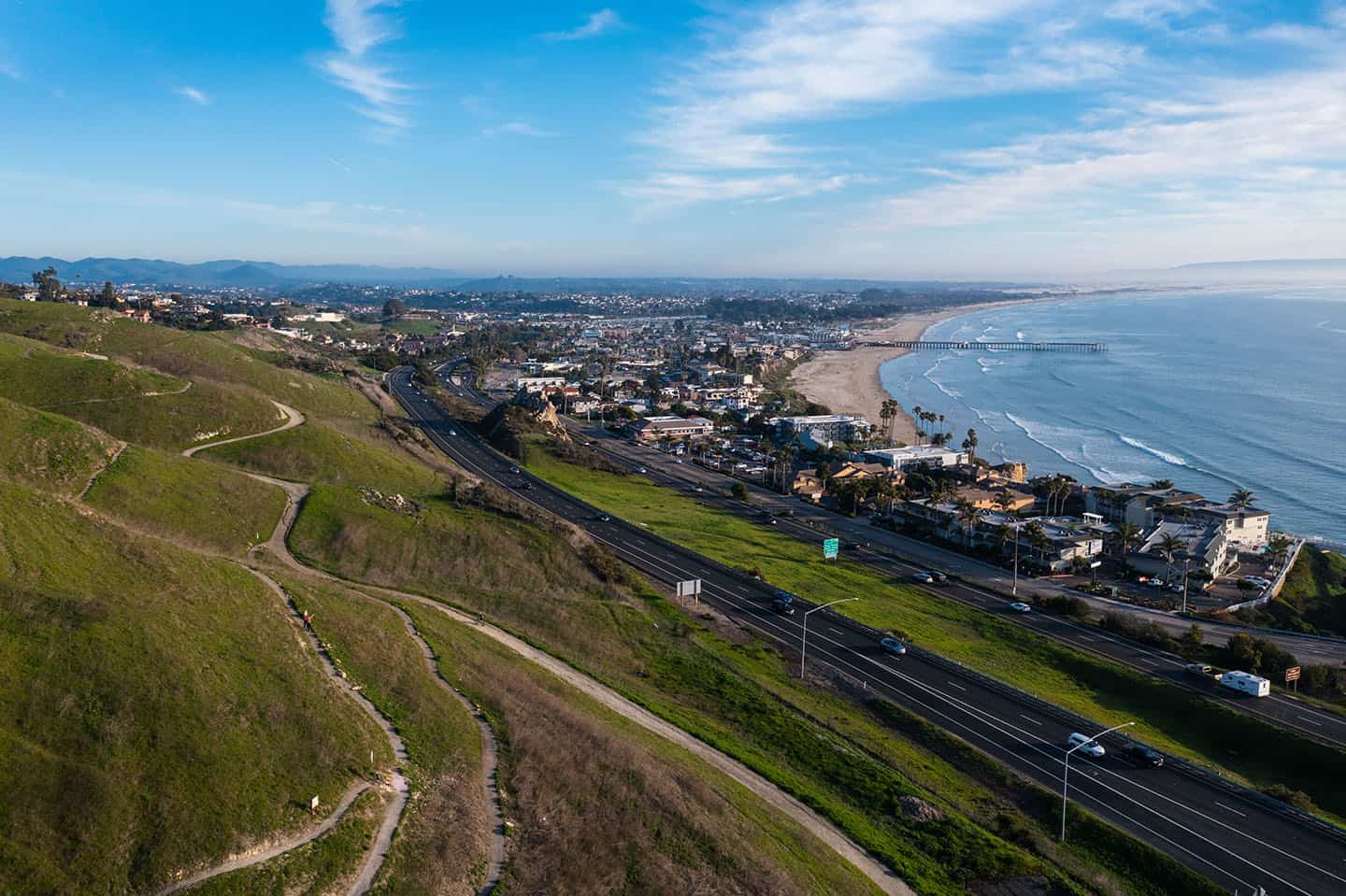
Pismo Beach Pier & Promenade
The Pismo Beach Pier & Promenade provides endless entertainment within arm’s reach of the ocean. Traverse the seaside promenade, followed by a leisurely stroll along Pismo Pier. While there, kids can try the concrete slides or partake in pier fishing. Nearby, find various shops, including renowned surf spots like Pancho’s and Moondoggies, as well as Hotlix, famous for its insect-studded lollipops. Stroll through Pismo Beach’s downtown for an authentic taste of classic California beach life. An array of dining options await, including iconic clam chowder at Splash Cafe. Food trucks also cluster near the pier, offering a range of delights from hot dogs to salads. Just steps away, shoot pool at Hot Shots Billiards or knock down a few pins Pismo Lanes..
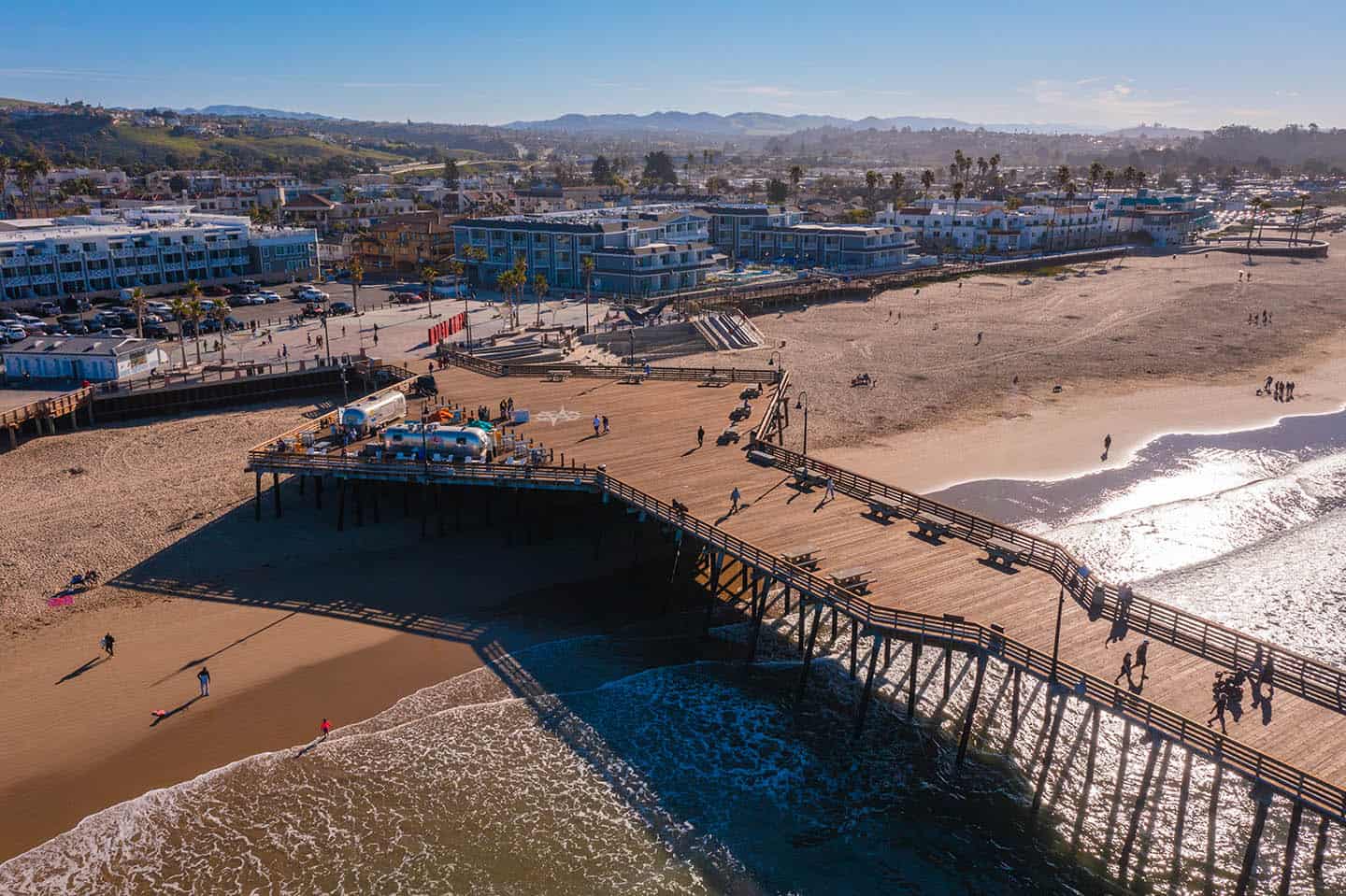
More Pismo Beach Adventure
Looking for more things to do in downtown Pismo Beach? Easily rent a wetsuit and board and hit the water for a day of surfing, boogie boarding or Stand Up paddle Boarding. Nearby, find craft beer hangouts and wine tasting rooms as well as an oceanside golf course. With year-round events in Pismo Beach, including the Pismo Clam Festival, Wine, Waves & Beyond and Fourth of July Fireworks, there’s always something exciting going on along this sunny slice of coastline.
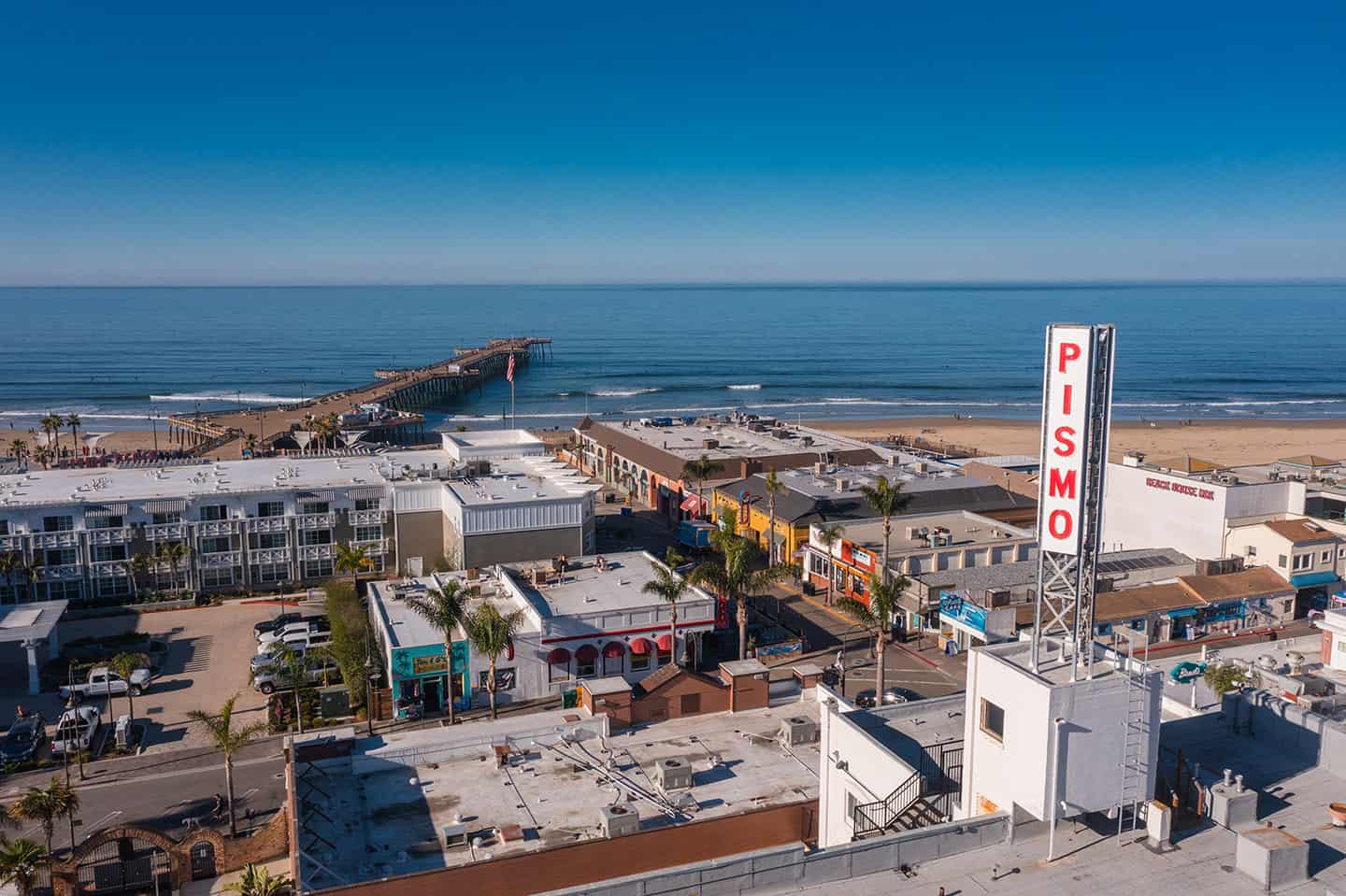
Local Dining Favorite
Ventana Grill
Indulge in fresh Mexican-California flavors with an ocean view at Ventana Grill in Pismo Beach. With stunning oceanfront vistas and a menu featuring coastal cuisine crafted from local ingredients, Ventana Grill offers an unforgettable dining experience by the water. Savor fresh seafood cooked with a Mexican twist, enchiladas, burgers, steak, and Sunday Brunch fare all while enjoying the beautiful coastal scenery. Known for pouring up stellar wine, beer and cocktails, patrons will also find an extensive list of tequilas and mezcals to round out the fun.
Things to do in Oceano
The Oceano Melodrama
While Oceano’s dunes might be well-known, The Great American Melodrama & Vaudeville Revue is a close second. Since 1975, this charming saloon-style theater on Highway 1 has been delighting visitors with musicals, comedies and classic melodramas in a cabaret setting. As a professional theater company, the Melodrama features talented actors acclaimed for their humor, musical skills and commitment to craft. Live piano accompaniment enhances each show in a traditional style suitable for all ages. Join in the fun from Wednesday to Sunday throughout most of the year, and relish in the opportunity to participate by hissing the villain and cheering the hero. Visitors should note that seasonal holiday shows are popular and tend to sell out quickly. Satisfy your appetite with the theater’s snack and bar offerings, personally served by the actors during intermissions. Dropping a tip in the jar earns patrons an amusing song performed by the actors.
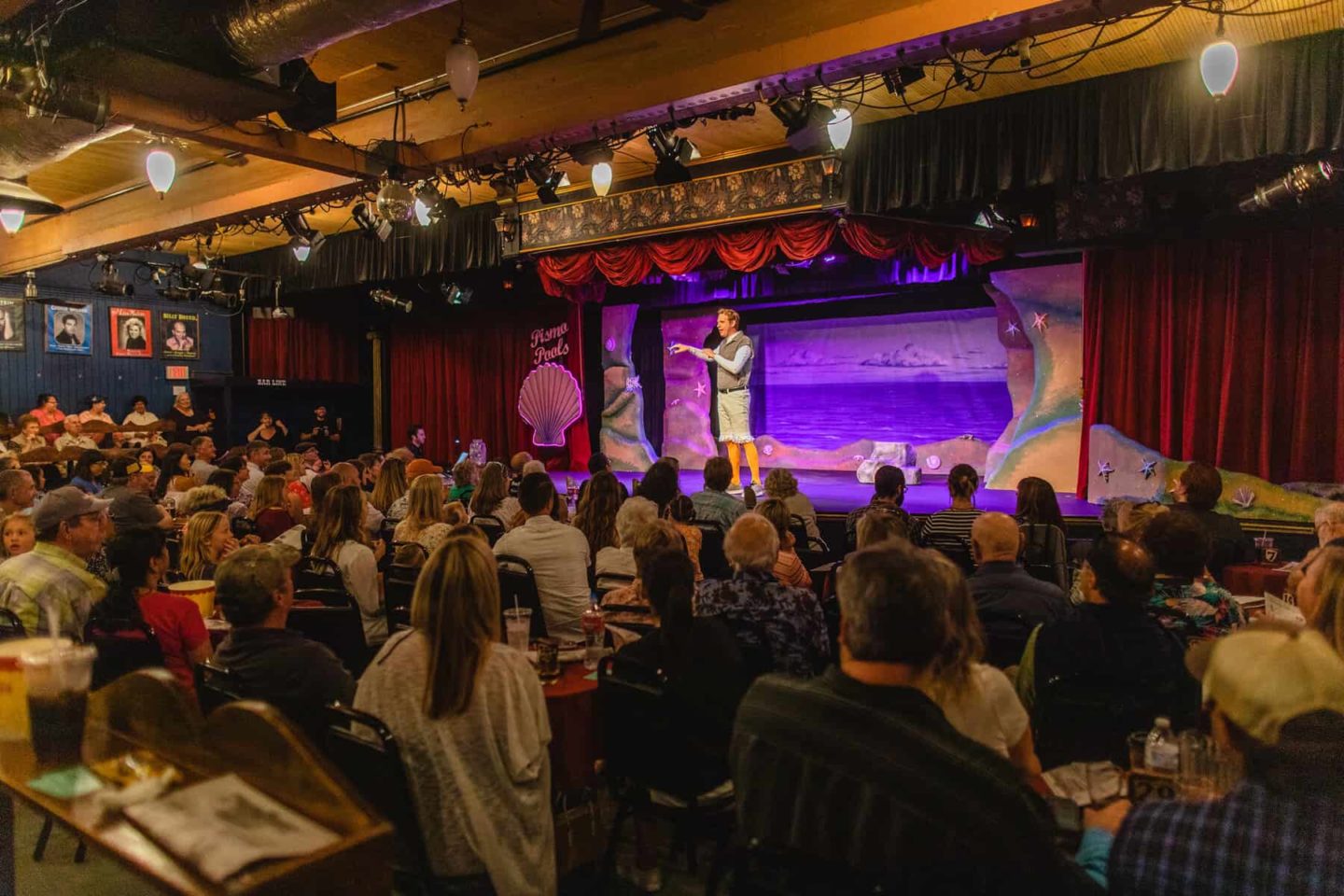
More to do in Oceano
Horseback Ride on the Beach
Discover the beauty of Oceano’s coastline while galloping across its sandy shores. Explore the Pacific Dunes Riding Ranch, conveniently located just off Highway 1 in Oceano, offering captivating beachfront horseback riding experiences. Knowledgeable guides lead both group and private trail rides from Friday to Tuesday, catering to ages 7 and above. (Younger children under 7 can enjoy pony rides within the corral.) With well-trained horses, riders are guided through wooded areas, dunes and beach. The ranch also offers equestrian camping amenities for those with their own horses, as well as horse boarding services. Riders of all skill levels are welcome, so you need not be an equestrian expert to partake in the adventure.
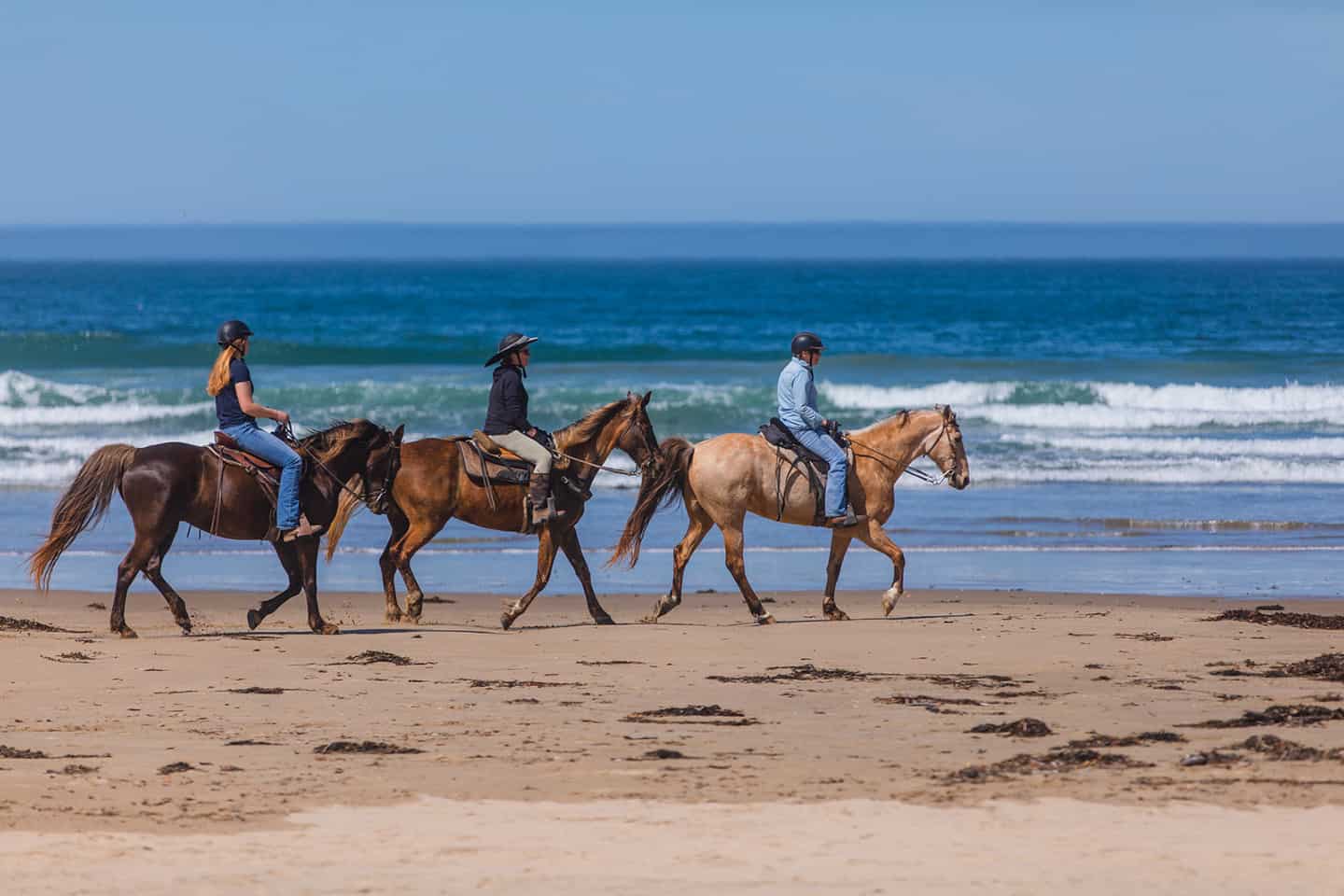
Biplane Rides
Soar high above Oceano with a thrilling biplane ride. Operating from Oceano Airport, Banner Airways presents aerial sightseeing tours over the Oceano Dunes in a vintage 1942 open cockpit plane. This iconic aircraft, featuring a 450-horsepower Pratt & Whitney radial engine, was a staple of U.S. military pilot training during World War II. Experience the nostalgia without combat training, as Banner Airways offers choices to view the Pismo Pier from above or both the Pismo Pier and the vast Oceano Dunes. For the daring, the “Top Gun” flight promises exhilaration with loops, twists and flips above Oceano. Complimentary essentials including a leather jacket, goggles, helmet, and life jacket enhance the experience.
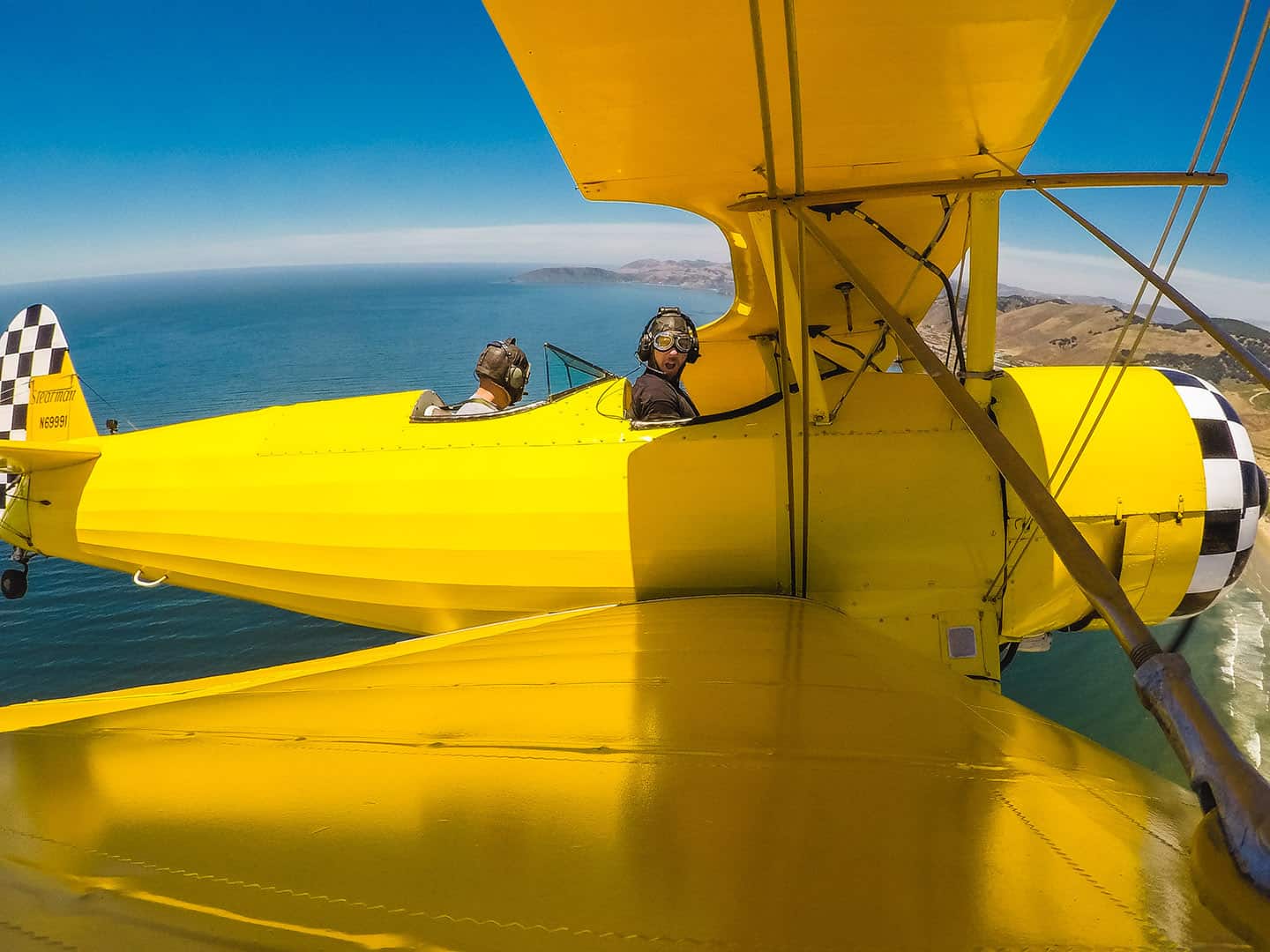
Humvee Tour
Off-road through Oceano with Humvee tours of the Oceano Dunes. Traverse the expansive dune landscape in rugged style and hold onto your seat. Guided tours offer a unique blend of excitement and awe, allowing visitors to witness the vastness of the dunes while chasing adrenaline-fueled fun. Whether seeking high octane thrills or a joyride through breathtaking scenery, Oceano Humvee tours provide an unmatched opportunity to motor along the sea.
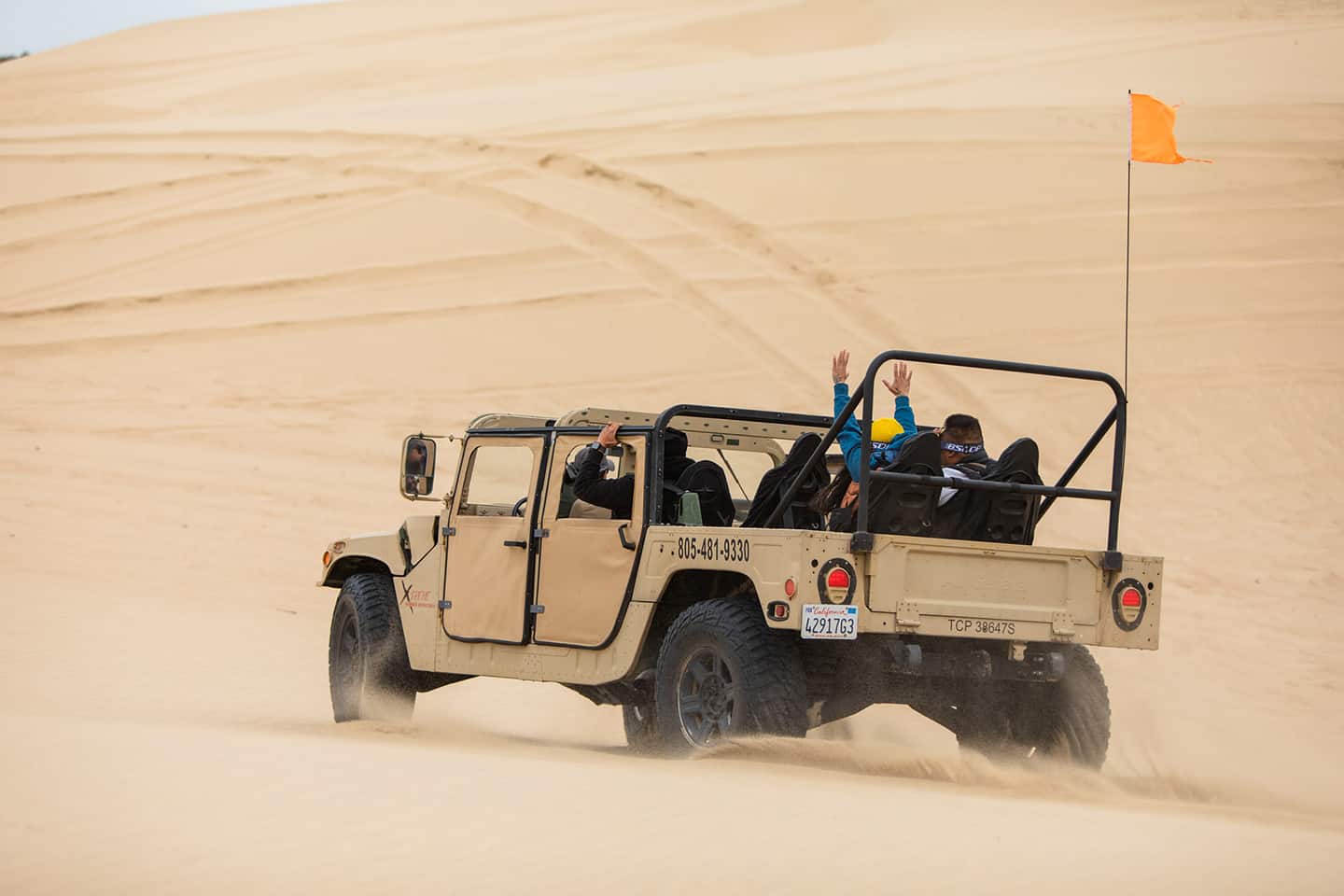
More Oceano Adventure
Looking for more things to do in Oceano? Dine on family-friendly favorites at Pier Street Deli in Oceano, where the sandwiches are locally famous. Explore more incredible attractions, including the nearby Nipomo Monarch Butterfly Grove, a sight to behold.
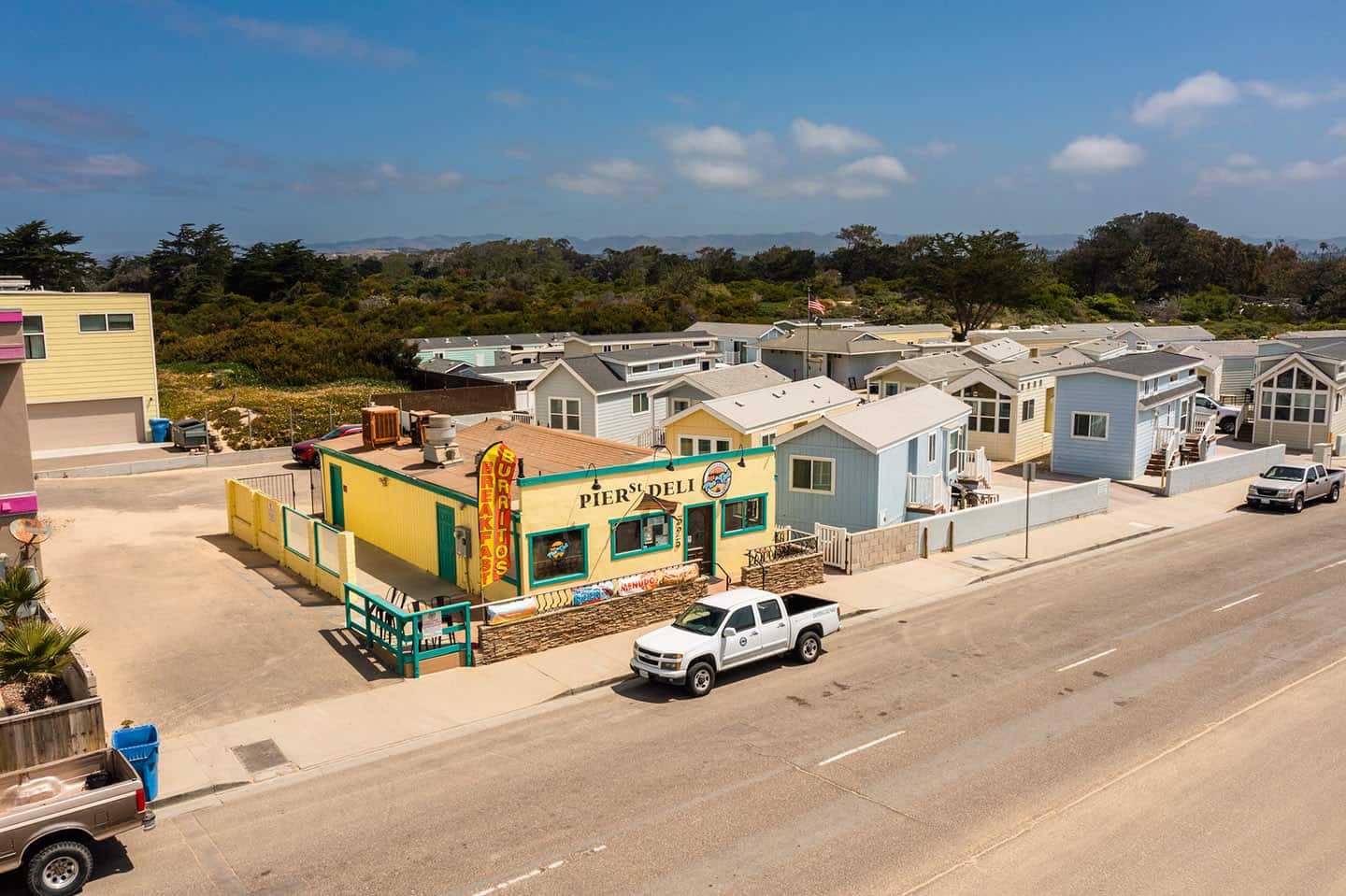
Local Dining Favorite
Rock and Roll Diner
Savor one of Highway 1’s classic burger joints at Rock and Roll Diner in Oceano. Housed within two authentic 1950s train cars—a 1946 Pullman dining car and a 1947 Budd lounge car, once part of Johnny Cash’s “Orange Blossom Special”—the diner features a nostalgic setting. Indulge in classic American fare like oversized burgers, crispy fries and creamy milkshakes. Notably, the diner is owned by a Greek proprietor, adding a twist to his “Big Fat Greek Menu,” known for an array of specialties. Hungry visitors should also check out our full overview of the best Oceano dining experiences and restaurants.
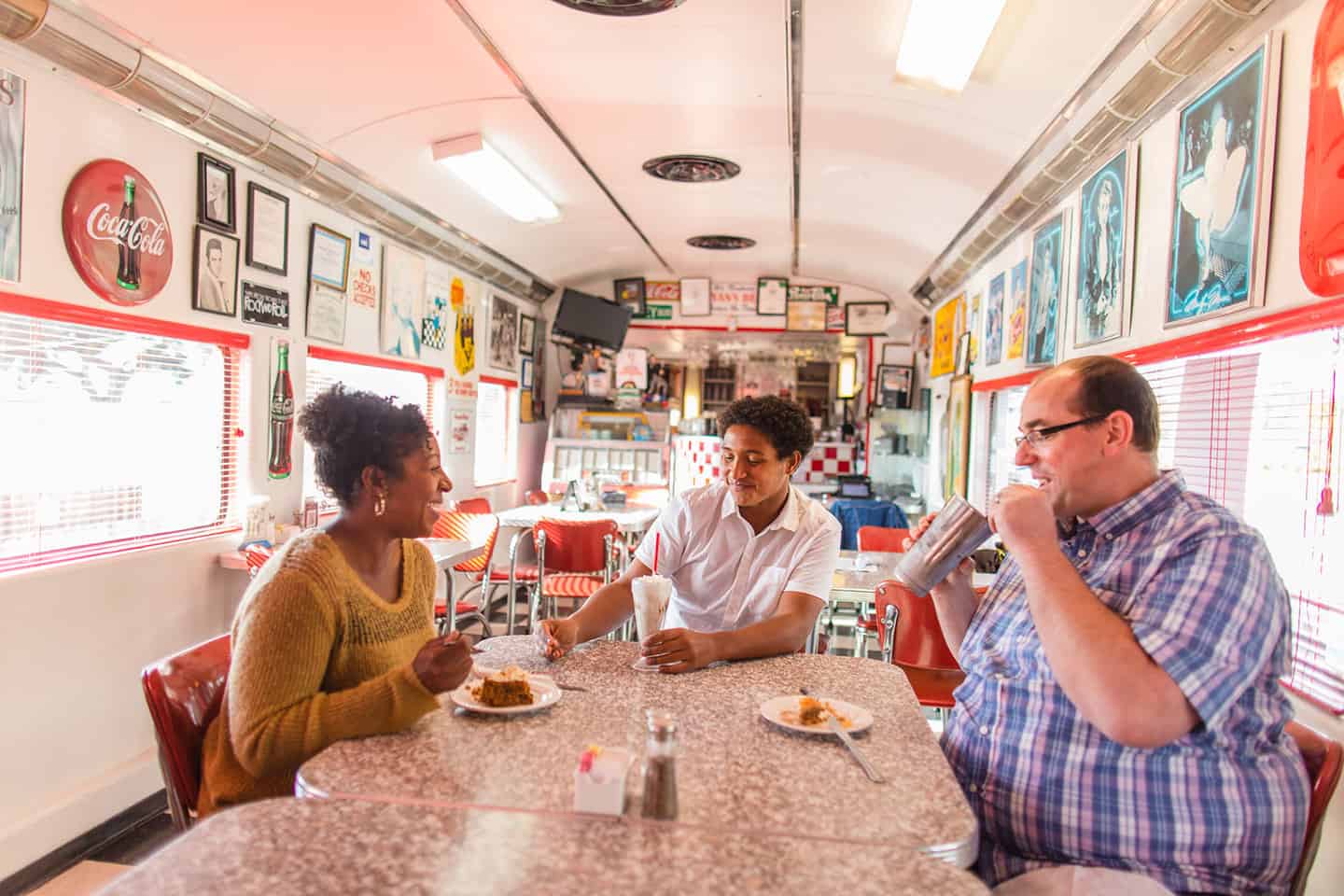
Things to do in Nipomo
The Monarch Habitat of Nipomo
Imagine seeing thousands of jewel-toned Monarch butterflies at once, tucked in and fluttering among the silvery leaves of a eucalyptus tree grove. Such a View countless Monarch butterflies fluttering in a eucalyptus grove just off Highway 1 in Nipomo. Adjacent to the Monarch Dunes Golf Course, this enchanting habitat is a haven for overwintering Monarchs each September through mid-February, with peak numbers reaching 60,000. The 19-acre Tasmanian Blue Gum Eucalyptus grove remains open year-round, inviting visitors to bask in its beauty from sunrise to sunset. Find relaxation at the picnic tables amidst the grove. Simply park at the parking lot at 1610 Kingston Drive in Nipomo and look for the interpretive sign from the Western Monarch Trail. For more Monarch hotspots, explore our list of Monarch Butterfly Groves on Highway 1.
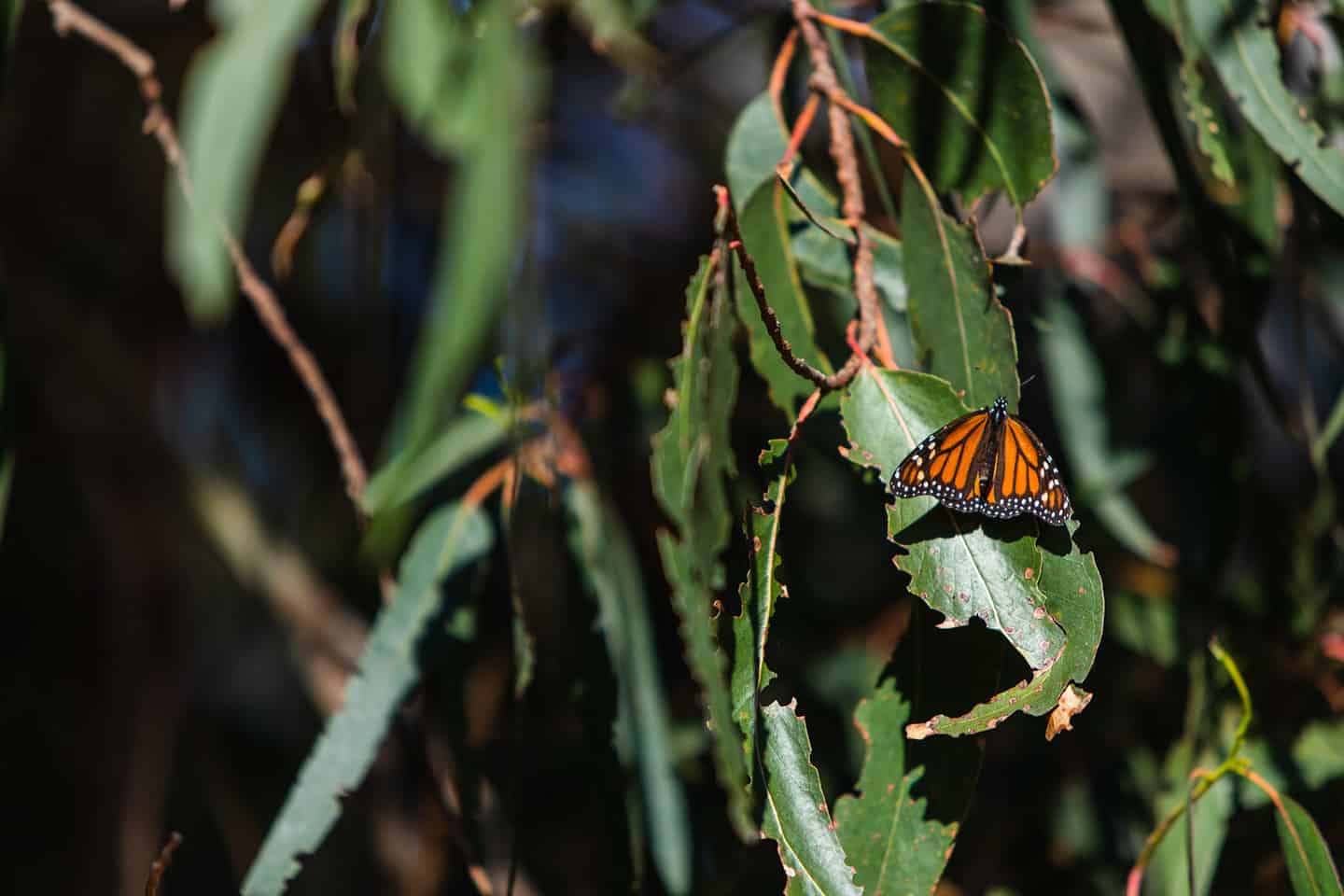
Other Stops Nearby
Monarch Dunes Golf Course
Nipomo is known for excellent golfing. Visit the Monarch Dunes Golf Course, just beside the Monarch habitat, for access to two of the finest golf courses on Highway 1. The first course built here, sometimes called “The Old Course,” is an 18-hole, par 71 championship-level track. The course was built in 2006 within a planned community called Woodlands Village. Architects Damian Pascuzzo and Steve Pate—the latter of whom is also a professional golfer—designed the course in the style of an oceanfront links track. Shortly after it opened, GOLF Magazine named the Old Course one of the world’s Top 10 New Courses. In 2008, the resort opened its Challenge Course, sometimes called the “New Course.” This 12-hole track is par 26, with 8,000-square-foot greens with elevation changes of up to four feet. On either course, enjoy views of the storm-fed lakes throughout the property, clean bentgrass greens, and a driving range. Don’t miss the Butterfly Grille for post-game celebrations over great grub, craft beer and local wines.
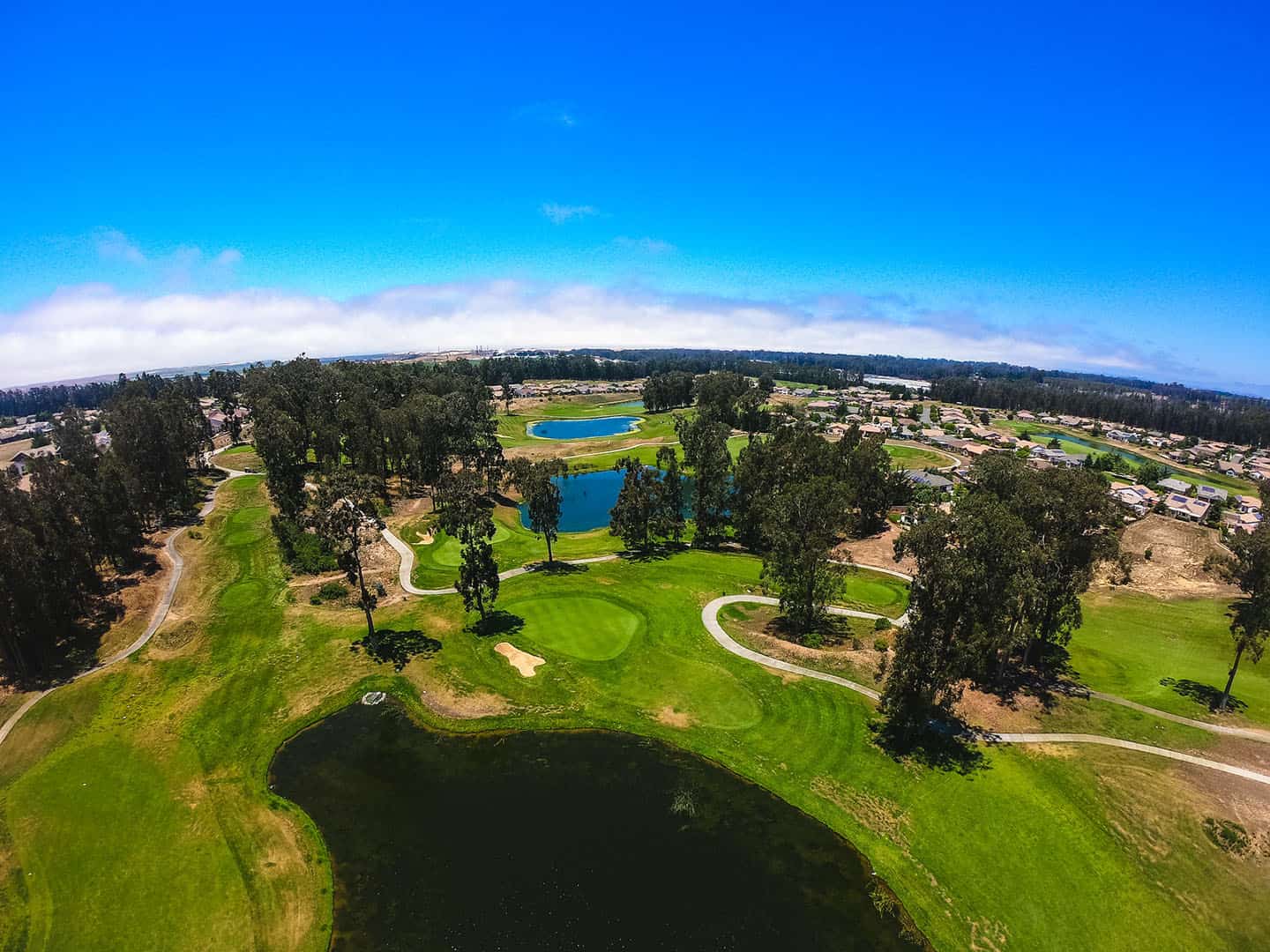
Dana Adobe
A trip to the Dana Adobe transports visitors to Nipomo’s frontier era. Constructed in 1839 by Captain William Goodwin Dana, this historic dwelling was established on the sprawling 38,000-acre Rancho Nipomo land grant. Captain Dana and his wife Maria Josefa raised their family of 16 children within these walls. During the California ranchos period, Dana’s Adobe played a pivotal role as a rest stop for travelers on El Camino Real en route to Mission San Luis Obispo. The trading post thrived, handling goods such as candles, soap, textiles and livestock. Thanks to dedicated volunteer endeavors for conservation, the Dana Adobe endures at the base of Nipomo hills as a California Historical Landmark and a National Register of Historic Places entrant. The surrounding countryside vistas, reminiscent of Dana’s era, offer a serene backdrop to this cultural attraction. Visitors can partake in guided tours, explore art displays, attend special events and classes and explore an array of walking trails on the adobe’s grounds.
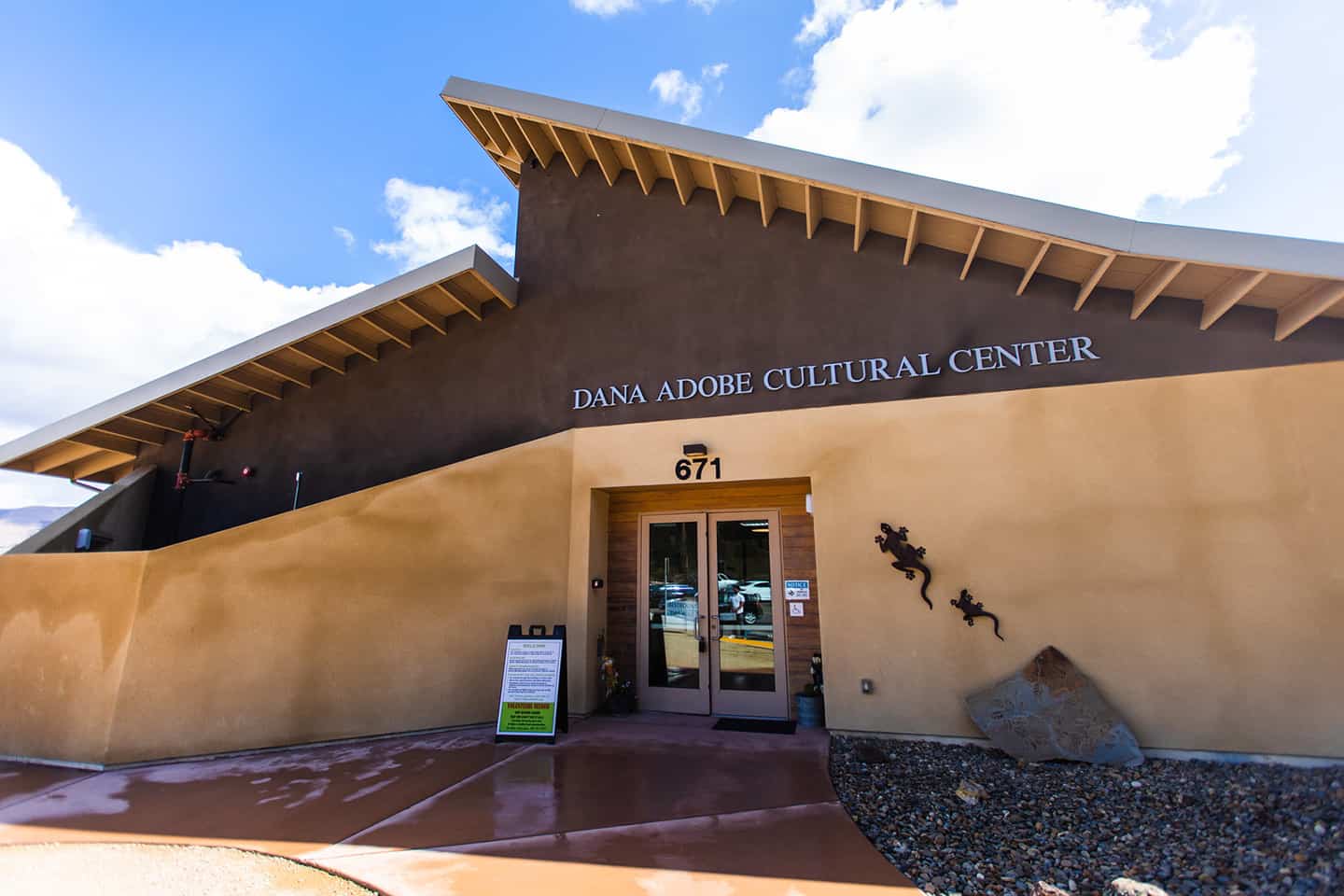
More Nipomo Adventure
Looking for more things to do in Nipomo? Enjoy a quiet stroll along the Oso Flaco Lake boardwalk, which winds from forest to dunes. Along the way, spot a multitude of bird species thriving in pristine landscape. Come hungry and leave satisfied after a great lunch at old school Nipomo hangout Jocko’s Steakhouse. Ready for a high-flying experience? Book an exhilarating biplane ride across the sunny Nipomo sky.
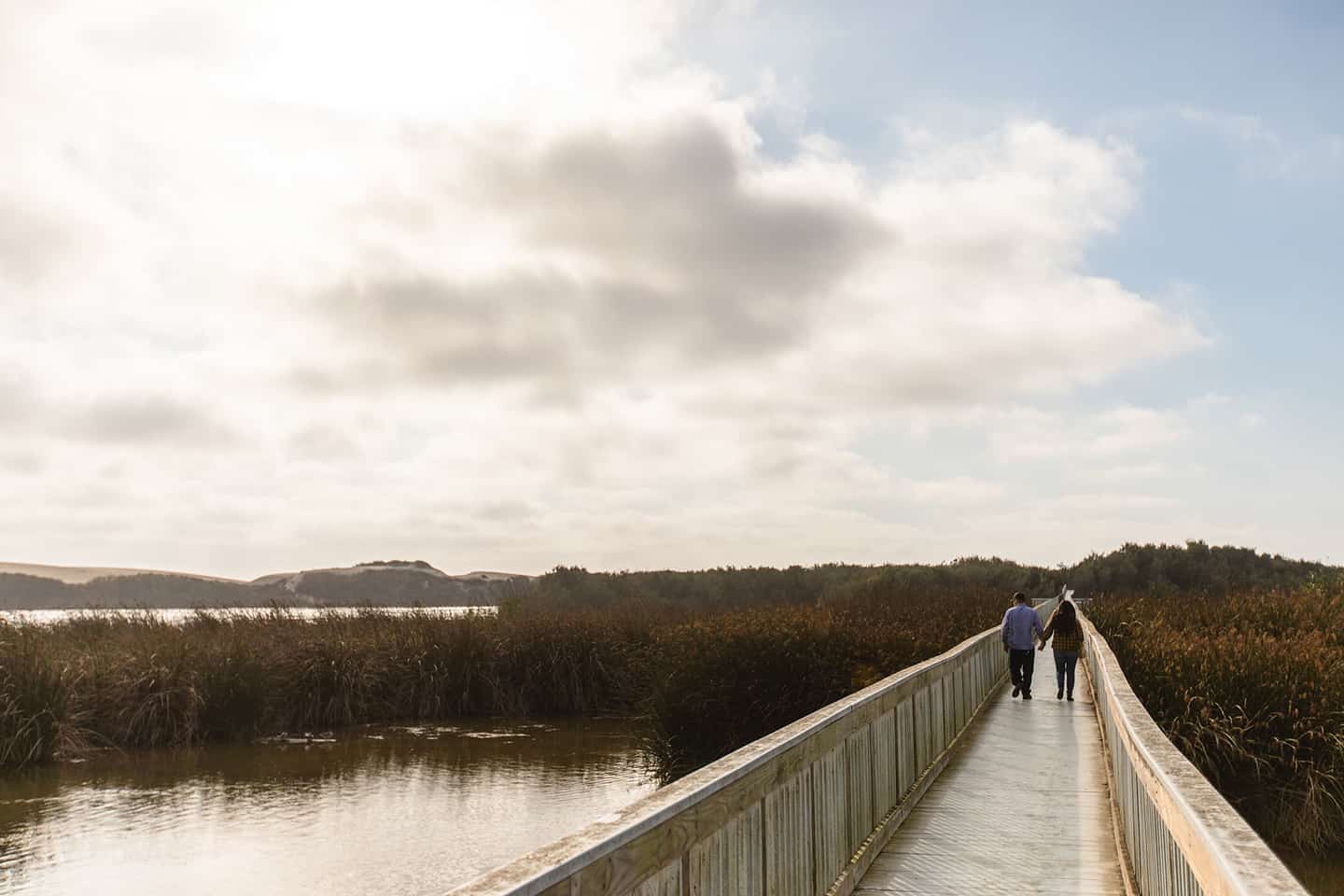
Local Dining Favorite
Dinner at Jocko’s
For an exceptional steak, visit Jocko’s Restaurant situated at the corner of Thompson Road and Tefft Street in Nipomo. Originally established in 1838 as a saloon, Jocko’s has evolved into an iconic West Coast barbecue destination. Founded by Ralph “Jocko” Knotts, it remains a family-owned establishment. Immerse yourself in Santa Maria-style hospitality with generous portions, a cozy bar and branded cattle motifs adorning the walls. While the menu features a diverse range of options including chicken, fish and vegetarian choices, the true standout is the renowned steaks. Indulge in various cuts, each flame-grilled over red oak coals on the outdoor Santa Maria-style barbecue pit. Meals include a relish tray, salad, garlic bread, Jocko’s signature beans, potatoes, ice cream and coffee. Hungry visitors should also check out our full overview of fantastic Nipomo dining offerings and restaurants.
